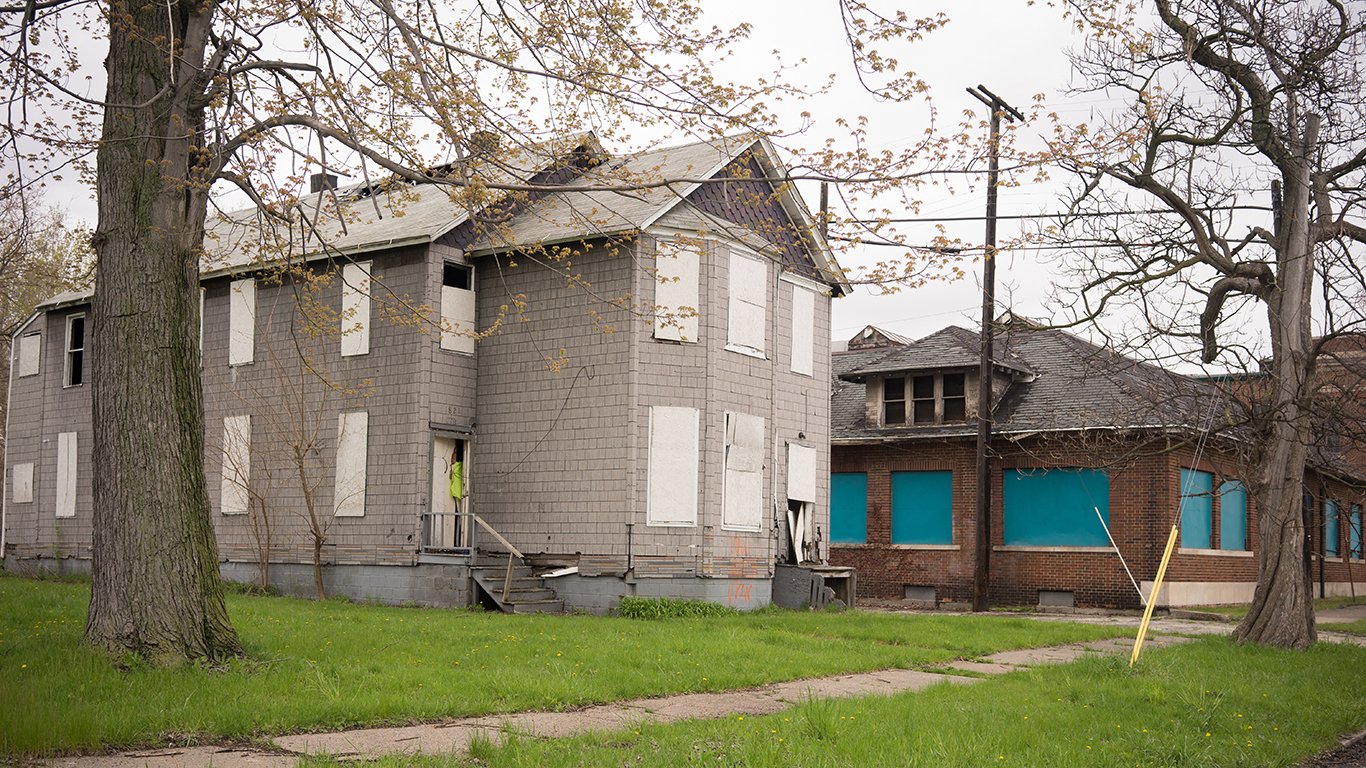

There are over 1.5 million vacant single family houses and condos in the United States. The reasons for why these homes are classified as vacant vary. Some are in popular vacation areas and are used only seasonally. Others are on the market, waiting for a renter or a buyer. Many, however, are effectively abandoned.
Nationwide, only about 1.6% of single-family homes are vacant. In some parts of the country, however, vacancy rates are many times the national figure, exceeding 20%, and even 30% in the most extreme cases.
24/7 Wall St. reviewed the share of single-family homes that were unoccupied as of the end of the third quarter of 2019 to identify the 30 ZIP codes with the highest vacancy rates — America’s ghost towns. Vacancy rates in these areas, which were calculated by ATTOM Data Solutions using tax assessor data, range from 16.0% to 31.3%.
The majority of ZIP codes on this list tend to be in urban areas in the South and Midwest. The vast majority of these areas with nation-leading vacancy rates are in Rust Belt cities. These cities have been hollowed out by the decline of American manufacturing and currently have little to offer in the way of economic opportunity.
Each of the 30 ZIP codes on this list has a poverty rate of over 30% — which is more than double the comparable national poverty rate of 14.6%. Many of these ZIP codes are concentrated within a single city. Places like Gary, Indiana; Flint, Michigan; Cleveland, and Detroit have multiple ZIP codes on this list. These cities are relatively poor, and some even rank among the poorest nationwide. Here is a list of the 50 poorest U.S. metro areas.
High vacancy rates are indicative of low demand for housing, and indeed, most of these areas have reported a population decline in the last five years. The reduced demand has likely led to declining home values.
In the last five years, the median home value has declined in the majority of the ZIP codes on this list. In stark contrast to these places, in some U.S. cities, home values have appreciated by over 10% in the last year alone. Here is a look at America’s fastest growing housing markets.
Additionally, in 28 of the ZIP codes on this list, the typical home is worth less than $75,000. For context, the median home value nationwide is $193,500.
Click here to see 30 American ghost towns.
Click here to see our methodology.
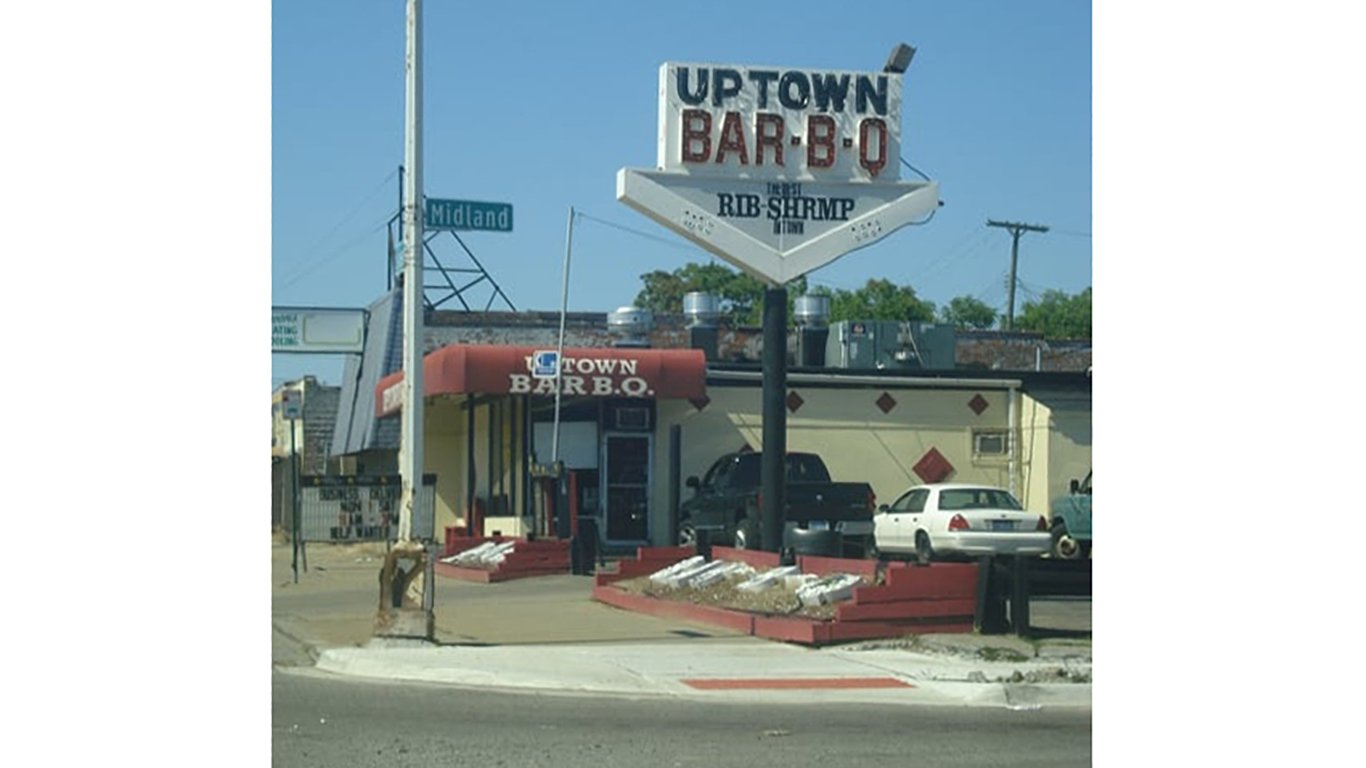
30. ZIP 48238 (Detroit, Michigan)
> Vacant homes: 1,720 (16.0%)
> 5-yr. Population change: -8.6%
> Population: 28,447
> Median home value: $34,800
The 48238 ZIP code is one of several in the city of Detroit with a near nation-leading vacancy rate. There are about 10,700 single family homes in the area — which is located northwest of downtown Detroit — and 1,720 of them are vacant, or 16.0%.
As is the case in most places on this list, people are moving out of the 48238 ZIP code. In the last five years, the area’s population has declined by 8.6%. The shrinking population and high vacancy rate have likely pushed area real estate values down. The typical area home is worth just $34,800.
[in-text-ad]
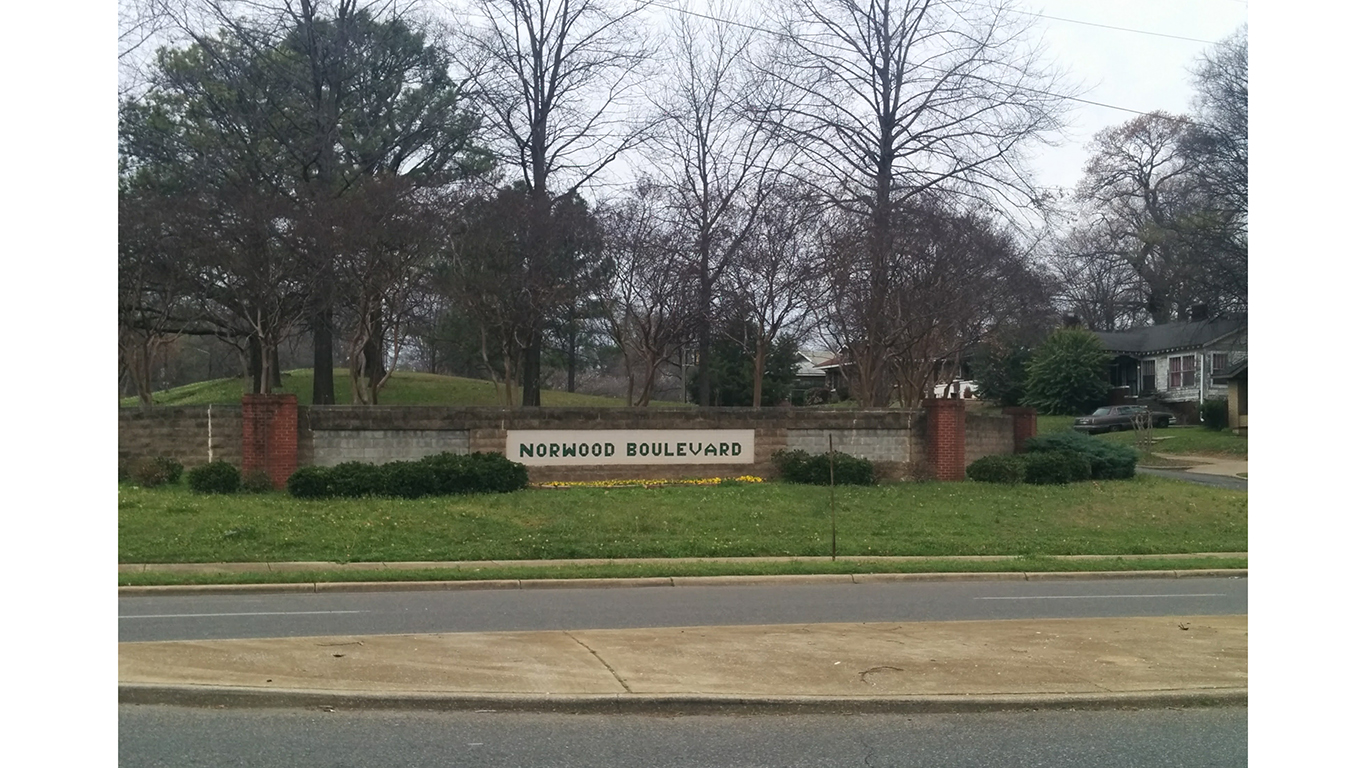
29. ZIP 35234 (Birmingham, Alabama)
> Vacant homes: 350 (16.2%)
> 5-yr. Population change: -10.2%
> Population: 5,446
> Median home value: $62,000
The 35234 ZIP code is located just north of downtown Birmingham, largely in between Interstate 20 and Interstate 65. Of the 2,167 homes in the area, 350 are vacant. The area’s higher than national average vacancy rate of 16.2% may be partially attributable to population decline. In the last five years, the number of people living in the ZIP code fell by 10.2%.
As is the case in nearly every other ZIP code on this list, economic opportunity appears to be scarce in the 35234 ZIP code. More than one in every three residents live below the poverty line, and most households earn less than $25,000 a year.
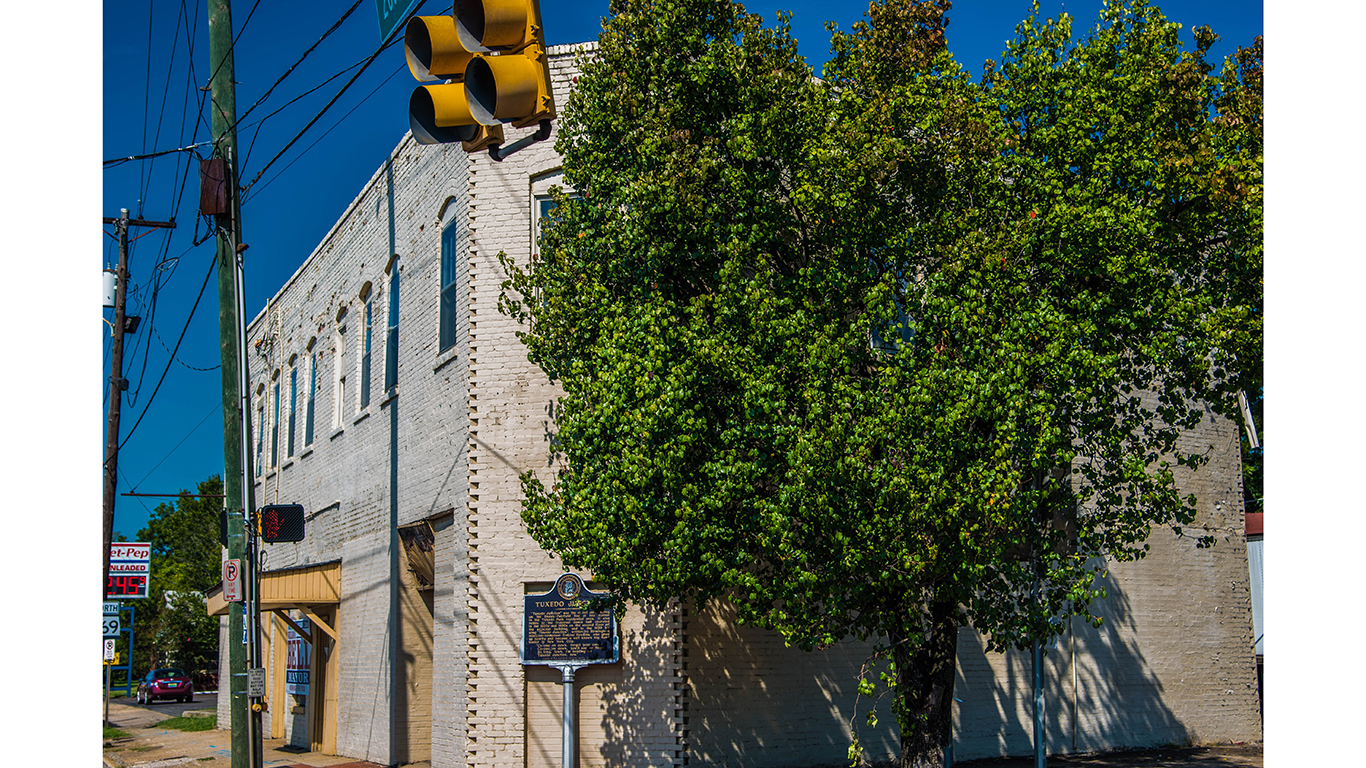
28. ZIP 35218 (Birmingham, Alabama)
> Vacant homes: 316 (16.2%)
> 5-yr. Population change: -5.3%
> Population: 7,097
> Median home value: $63,800
The 35218 ZIP code, located in western Birmingham, is one of a handful of Alabama ZIP codes to rank on this list. There are 316 vacant properties in the area, equal to 16.2% of all area homes.
The vacancy problem in the area is likely made worse by population decline. In the last five years, the number of people living in the area declined by 5.3%. The exodus may be attributable in part to a lack of economic opportunity — as like many ZIP codes on this list, this section of Birmingham is poor. Most area households earn less than $25,000 a year, and over 41% of area residents live below the poverty line.
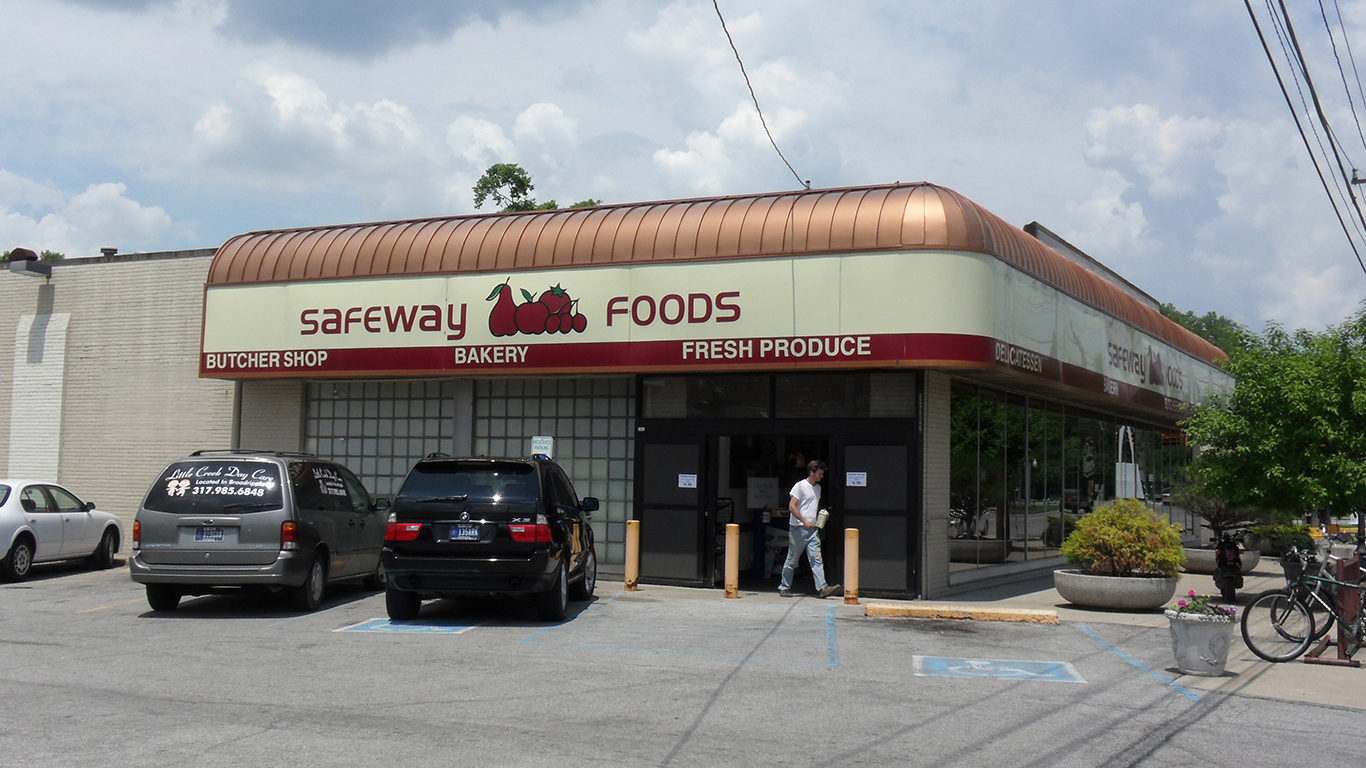
27. ZIP 46208 (Indianapolis, Indiana)
> Vacant homes: 1,337 (16.4%)
> 5-yr. Population change: 2.3%
> Population: 23,300
> Median home value: $103,900
There are 1,337 vacant properties in the north-central Indianapolis ZIP code of 46208, up from fewer than 1,000 a year prior. Relatively few vacant properties in the area are likely abandoned, however, as the vast majority are classified as investment properties, meaning they are likely either on the rental market or waiting to be sold at a profit by the owner. However, real estate values in the area appear to be declining. In the last five years, the value of the typical home fell from $108,300 to $103,900, a 4.1% drop.
[in-text-ad-2]
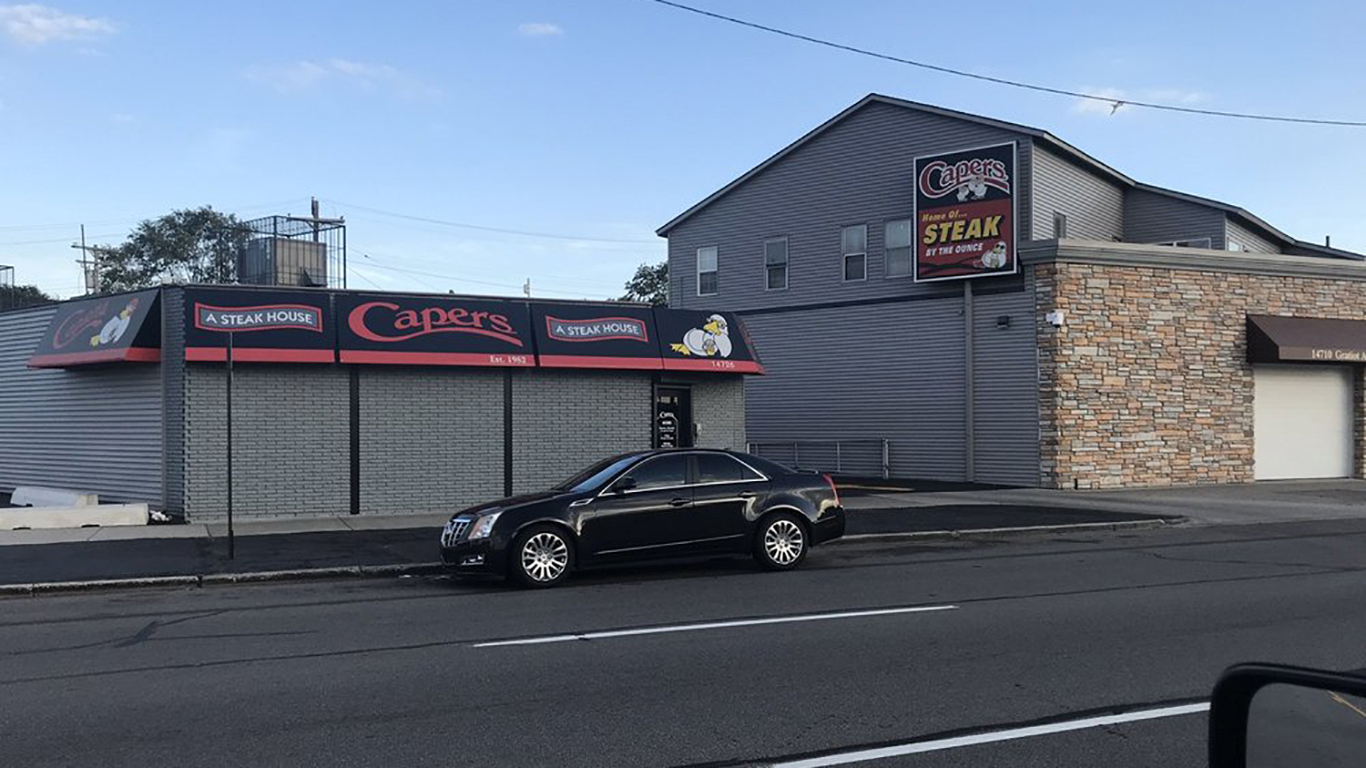
26. ZIP 48205 (Detroit, Michigan)
> Vacant homes: 2,138 (16.4%)
> 5-yr. Population change: -10.5%
> Population: 34,620
> Median home value: $30,600
The 48205 ZIP code is located in northern Detroit and is one of three areas in Motor City with near nation-leading home vacancy rates. There are over 2,100 vacant homes — or 16.4% of all homes — in this part of the city. As is often the case, the area’s high vacancy rate is likely tied to rapid population decline. In the last five years, the number of people living in the area has fallen by over 10%.
Reduced demand for housing and the high vacancy rate have likely had a chilling effect on property values. The typical area home is worth just $30,600, down a staggering 31.7% from five years earlier, when the typical area home was worth $44,800.
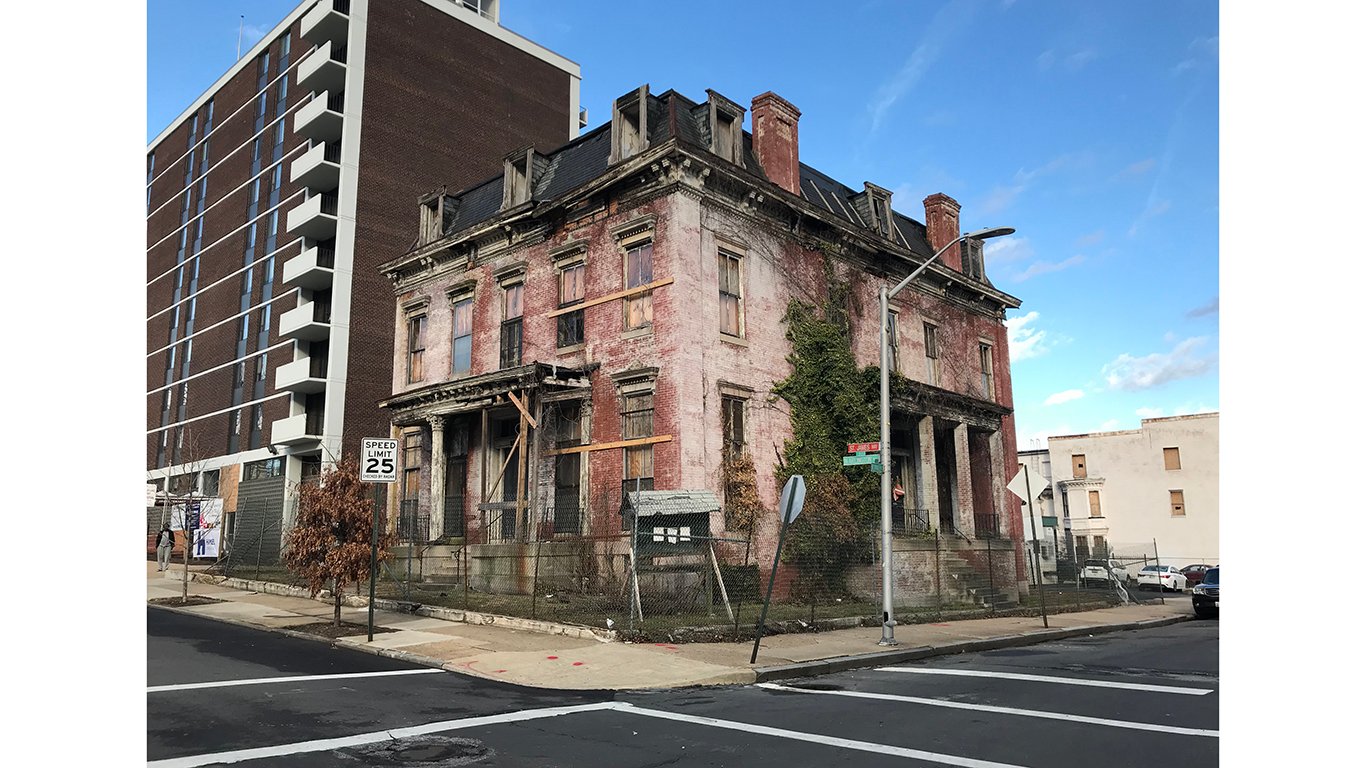
25. ZIP 21217 (Baltimore, Maryland)
> Vacant homes: 2,190 (16.6%)
> 5-yr. Population change: -9.6%
> Population: 36,563
> Median home value: $130,500
Situated on the south side of Druid Hill Park in northwest Baltimore, the 21217 ZIP code covers the city’s Reservoir Hill, Penn North, Druid Heights, Bolton Hill, and Upton neighborhoods. Across Baltimore as a whole, there are about 17,000 vacant properties, which have been driving up crime and dragging down property values for about a decade. In the 21217 ZIP code alone, 16.6% of all residences are vacant.
Of the 2,190 vacant homes in the area, however, more than 1,500 are classified as investment properties, which suggests that their owners may be renovating them or waiting for them to appreciate to sell. And unlike many ZIP codes on this list, property values are on the rise in this part of Baltimore. The typical area home is worth $130,500, a 15.6% increase from the median home value in the area five years earlier.
[in-text-ad]
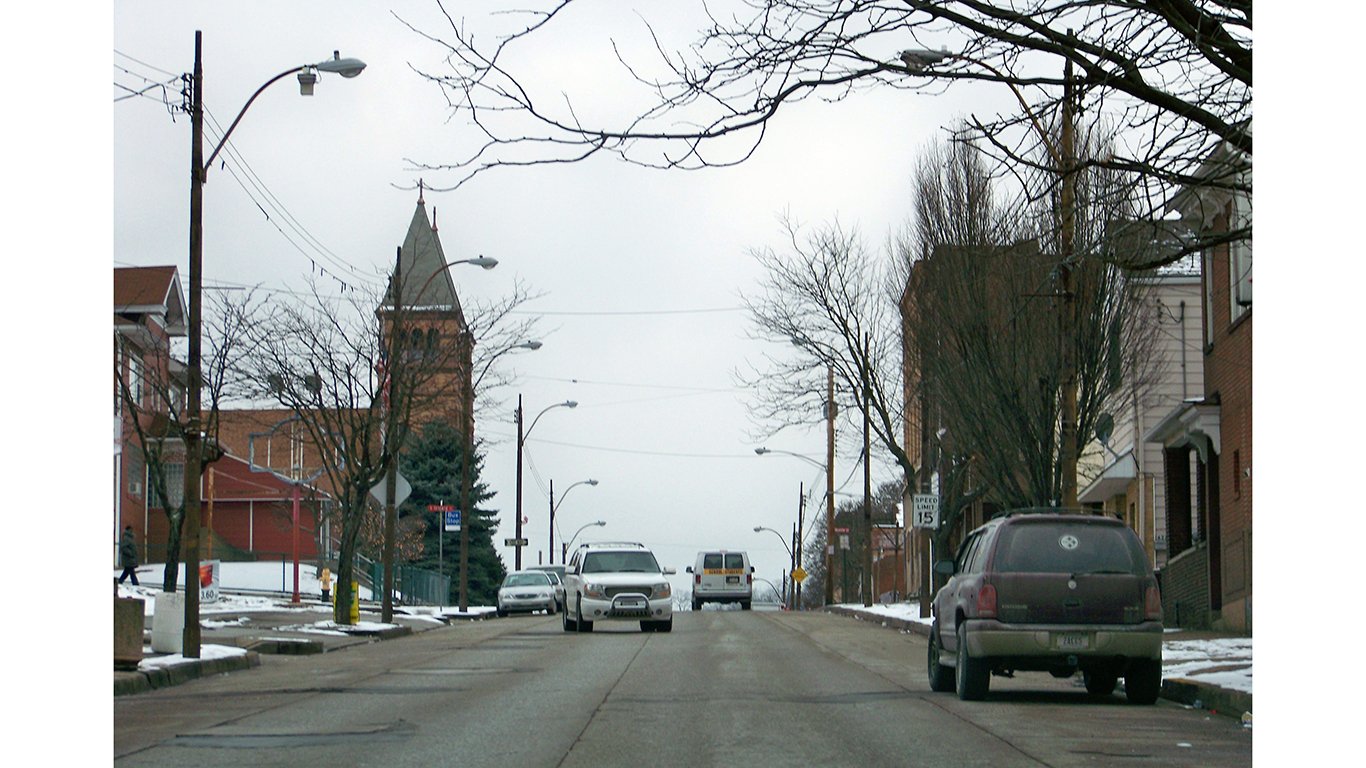
24. ZIP 15110 (Duquesne, Pennsylvania)
> Vacant homes: 345 (16.6%)
> 5-yr. Population change: -0.7%
> Population: 5,544
> Median home value: $37,800
The 15110 ZIP code in western Pennsylvania sits along the west bank of the Monongahela River and covers the small city of Duquesne. Of the 2,075 residential properties in the area, 345 are vacant. Like many parts of the country on this list, the ZIP code around Duquesne is poor. Most area households earn less than $25,000 a year, and 36.3% of area residents live below the poverty line.
Home values in the area are also low and do not appear to be improving. The typical area home is worth just $37,800, down from $38,300 five years earlier.
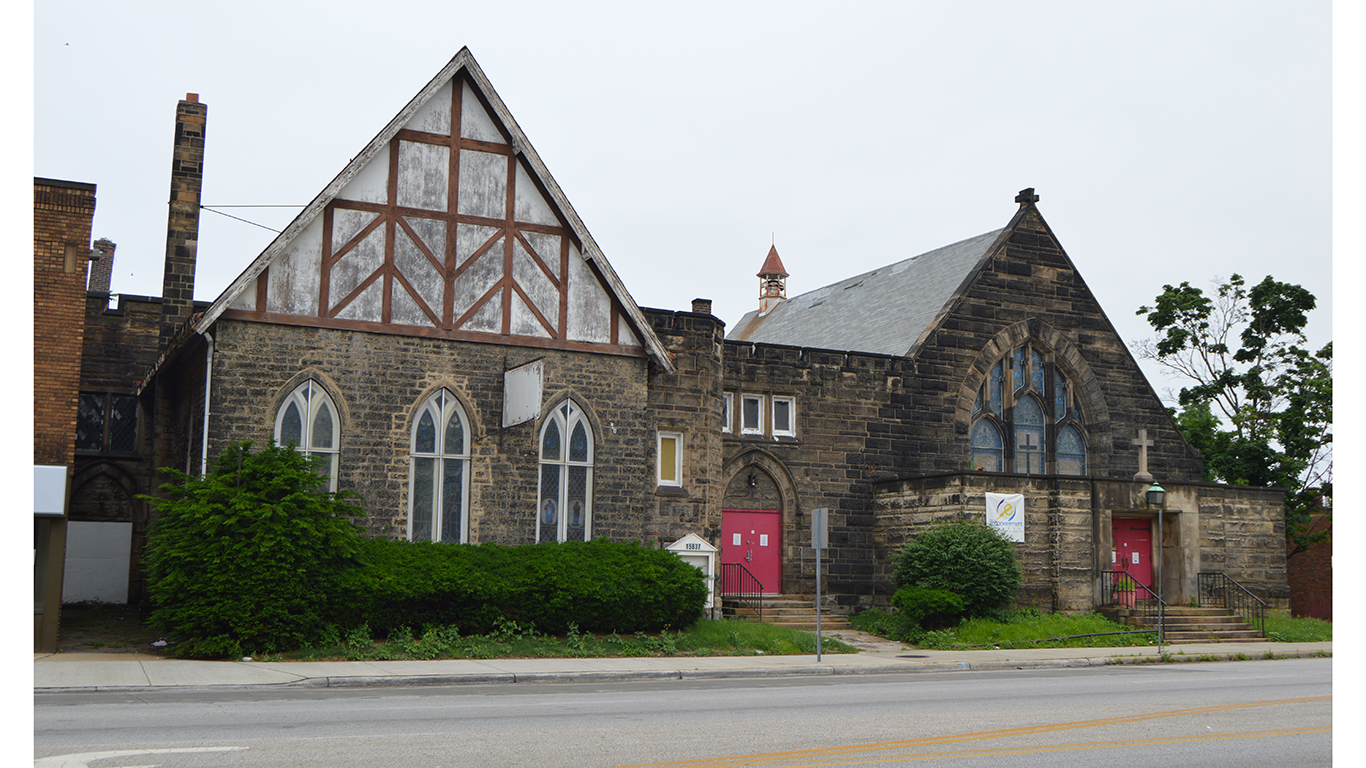
23. ZIP 44112 (Cleveland, Ohio)
> Vacant homes: 1,148 (16.7%)
> 5-yr. Population change: -3.6%
> Population: 21,788
> Median home value: $59,800
The number of vacant properties in Cleveland’s 44112 ZIP code has increased substantially in recent months. There are currently 1,148 vacant homes in the area, located around the neighborhood of East Cleveland, up from 771 one year ago. The growing vacancy problem is likely tied in part to the area’s population decline. In the last five years, the number of people living in East Cleveland fell by 3.6%.
One common explanation for population decline in a given ZIP code is poor economic conditions — and many living in the 44112 ZIP code are struggling. Most area households earn less than $23,000 a year, and 38.7% of area residents live in poverty.
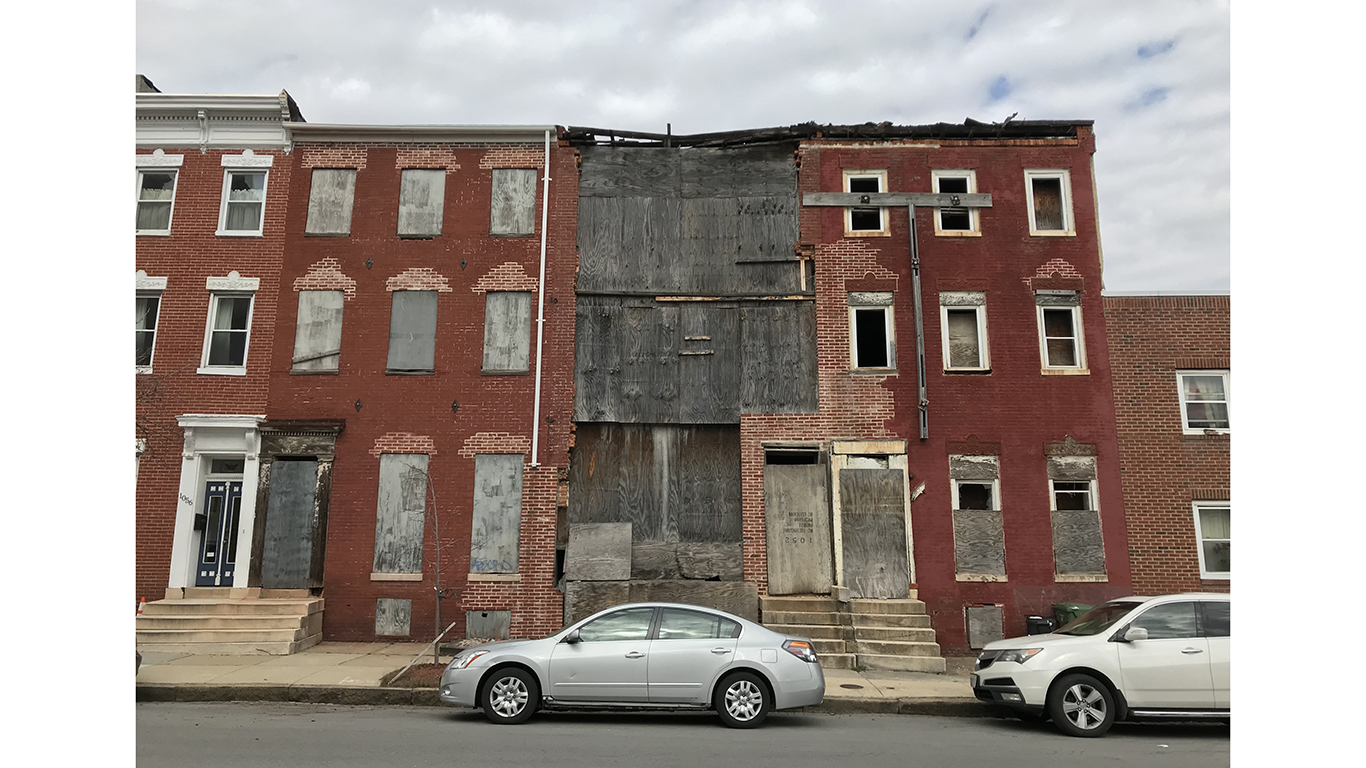
22. ZIP 21223 (Baltimore, Maryland)
> Vacant homes: 2,093 (16.7%)
> 5-yr. Population change: -1.0%
> Population: 23,811
> Median home value: $68,900
Baltimore’s 21223 ZIP code is one of only a few mid-Atlantic areas — and one of only two zip codes in Maryland — to rank on this list. Located just west of Baltimore’s Inner Harbor, the 21223 ZIP code has a far larger than typical share of vacant homes, at 16.7%.
The city of Baltimore as a whole has had a vacancy problem for some time. For the last 10 years, there have been about 17,000 vacant buildings across the city. In an effort to reduce that number, the city Housing Commissioner Michael Braverman has pledged to demolish about 2,000 of them in the next year. The 21223 ZIP code has already seen some improvement, as there are now 2,093 vacant properties, about 60 fewer than there were a year ago.
[in-text-ad-2]
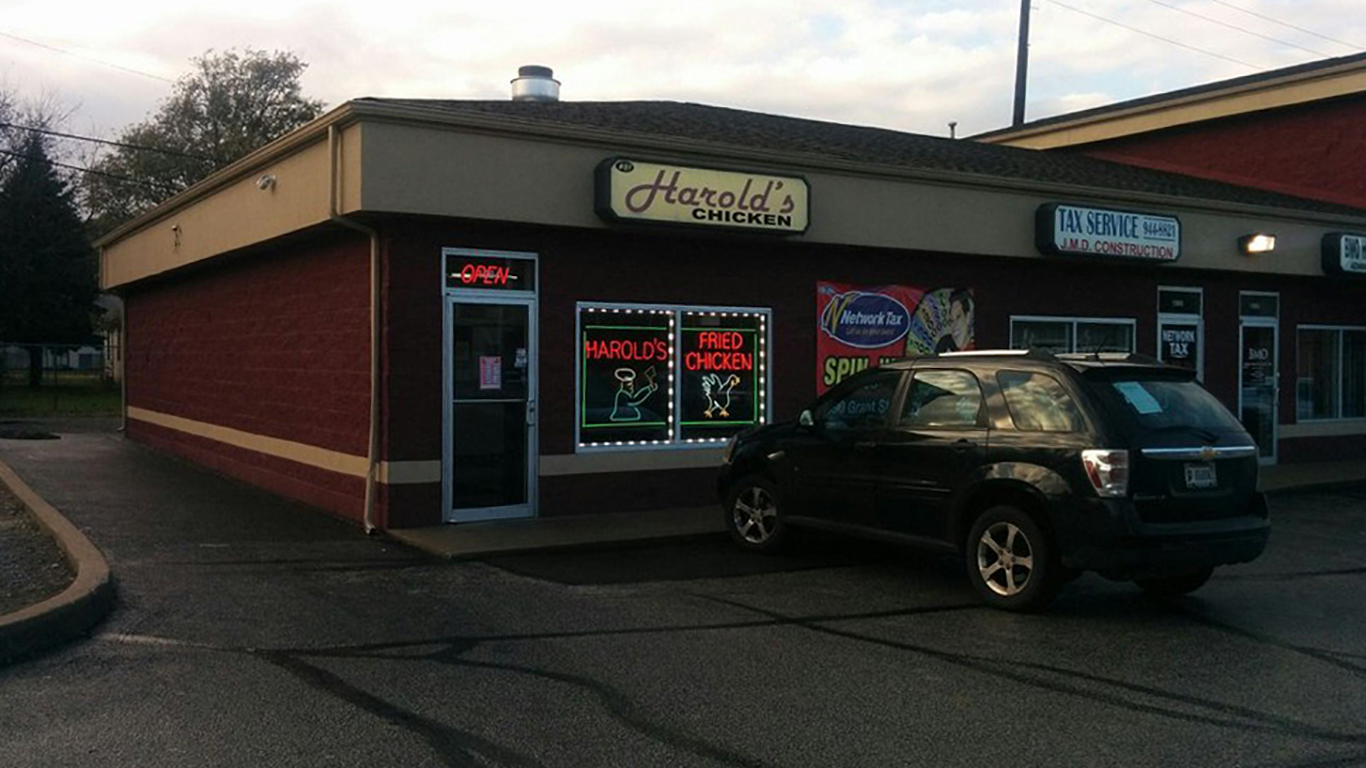
21. ZIP 46404 (Gary, Indiana)
> Vacant homes: 1,073 (16.9%)
> 5-yr. Population change: 2.7%
> Population: 17,441
> Median home value: $69,600
The 46404 ZIP code is one of several parts of the Rust Belt city of Gary, Indiana, to rank on this list. The area is located in west-central Gary, largely in between Interstate 90 and Interstate 94. Over 1,000 of the area code’s 6,349 homes are vacant, and many of those are likely abandoned.
Gary, a town founded by a steel company, has been in steady decline along with the American steel industry itself since the mid-20th century. The city’s population peaked at over 178,000 in 1960 and has since been cut by more than half.
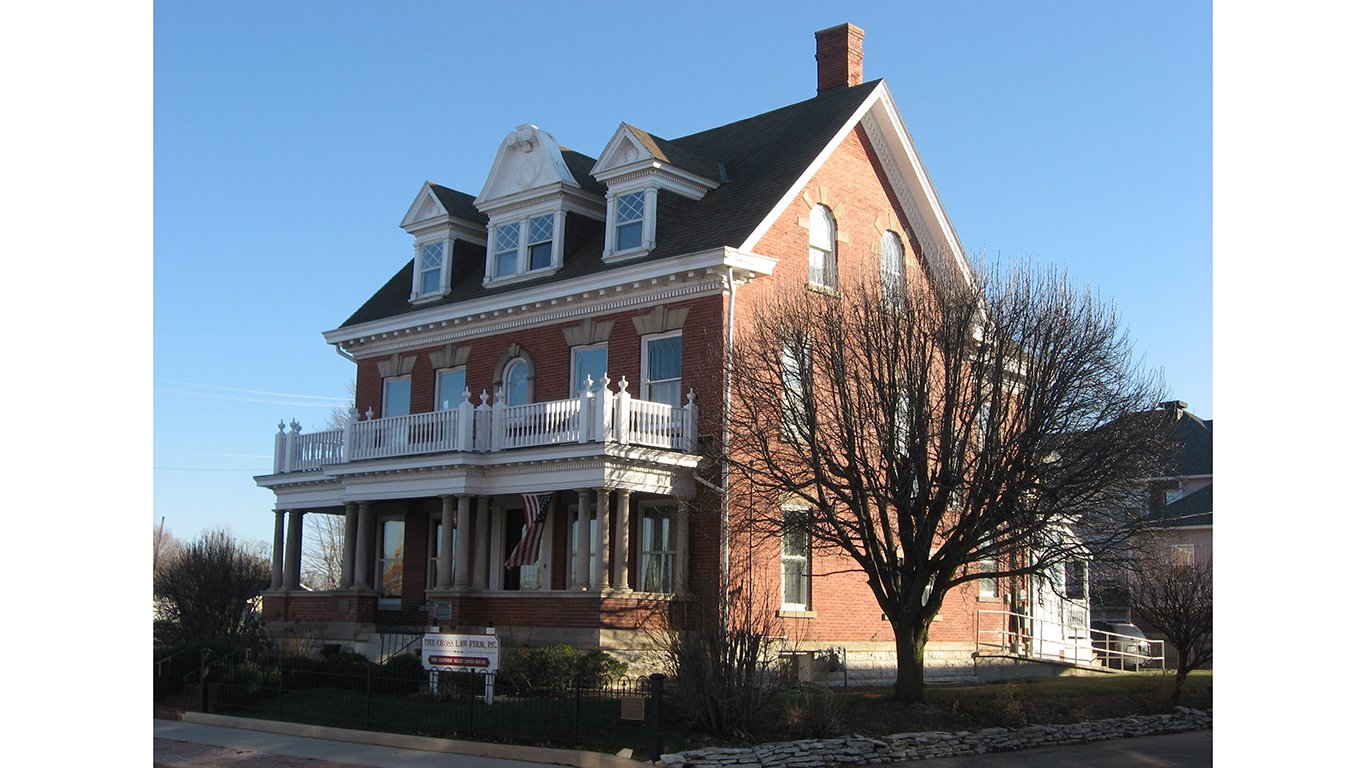
20. ZIP 47305 (Muncie, Indiana)
> Vacant homes: 202 (16.9%)
> 5-yr. Population change: -12.1%
> Population: 3,639
> Median home value: $53,300
The 47305 ZIP code in Muncie, Indiana, along the south bank of the White River has a 16.9% vacancy rate, one of the highest in the United States. One likely explanation for the high vacancy rate in the area is rapid population decline in recent years. There are now just over 3,600 people living in the ZIP code, 12.1% less than there were five years ago.
Economic opportunities are often scarce in places with such steep population decline, and Muncie’s 47305 ZIP code is no exception. Most area households have an income of less than $24,000 a year, and a staggering 42.5% of the population live below the poverty line.
[in-text-ad]
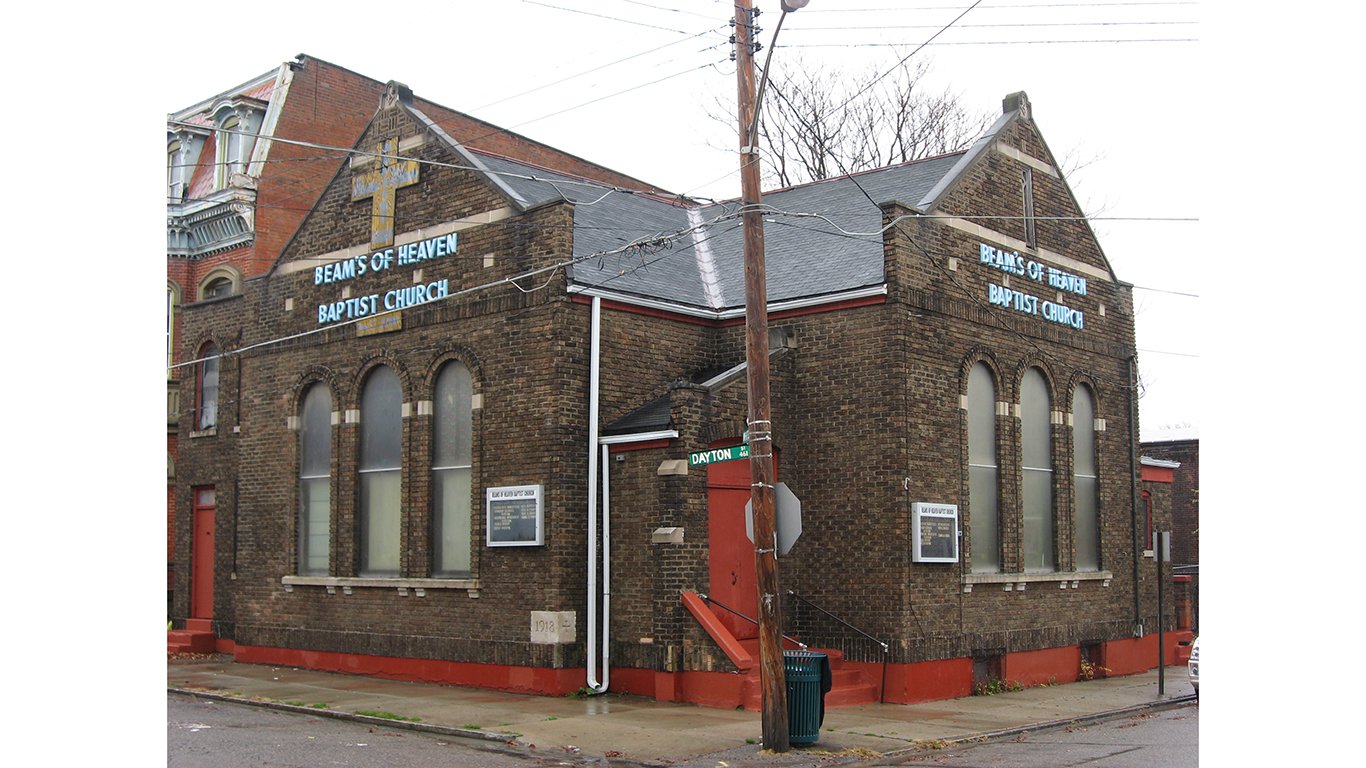
19. ZIP 45214 (Cincinnati, Ohio)
> Vacant homes: 277 (17.0%)
> 5-yr. Population change: 0.3%
> Population: 8,366
> Median home value: $62,100
The 45214 ZIP code, which extends from just west of Cincinnati’s Washington Park up through the West End neighborhood over Mill Creek and into the Fairmount neighborhood, is one of many parts of Ohio to rank on this list. There are 277 vacant homes in the area, up from 213 a year ago.
The majority of vacant properties in the area are classified as investment properties, meaning they are likely either on the rental market or waiting to be sold at a profit by the owner. And despite the high vacancy rate, property in the area appears to be appreciating in value. In the last five years, the typical home increased in value by 8.4%, from $57,300 to $62,100.
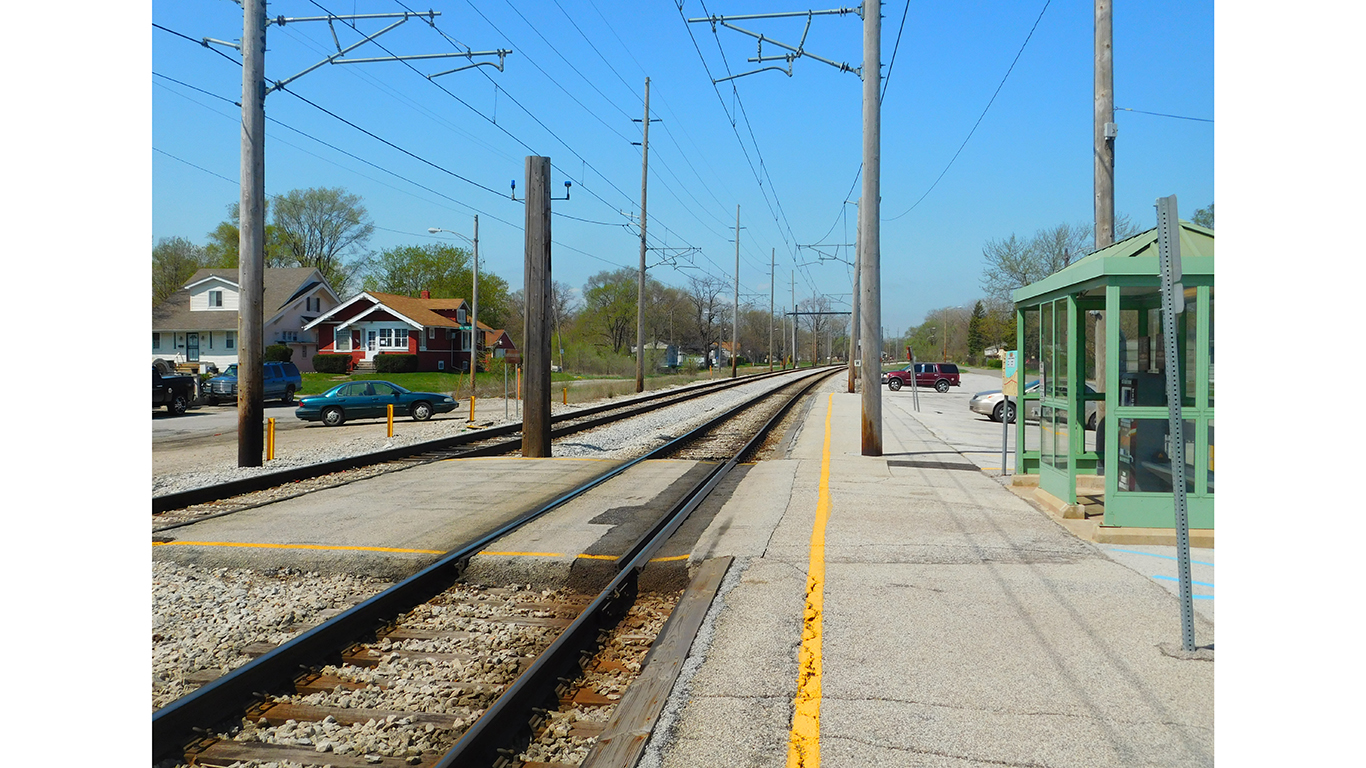
18. ZIP 46406 (Gary, Indiana)
> Vacant homes: 599 (17.2%)
> 5-yr. Population change: -4.4%
> Population: 9,462
> Median home value: $54,600
Gary, Indiana, was founded and operated by U.S. Steel. As the steel industry declined, so did Gary. The city has faced widespread socioeconomic problems, including drugs, violent crime, and widespread poverty. Due in part to longer-term population decline, today, in the 46406 ZIP code in western Gary, 599 homes are vacant.
As is often the case, many of the vacant properties in this part of Gary are investment properties — meaning they are likely either on the rental market or waiting to be sold at a profit by the owner. If recent trends are any indication, it may be a while before a real estate investment in the area pays off. The typical area home is worth just $54,600, down 10.2% from five years ago. Over the same period, the typical American home has appreciated in value by 9.5%.
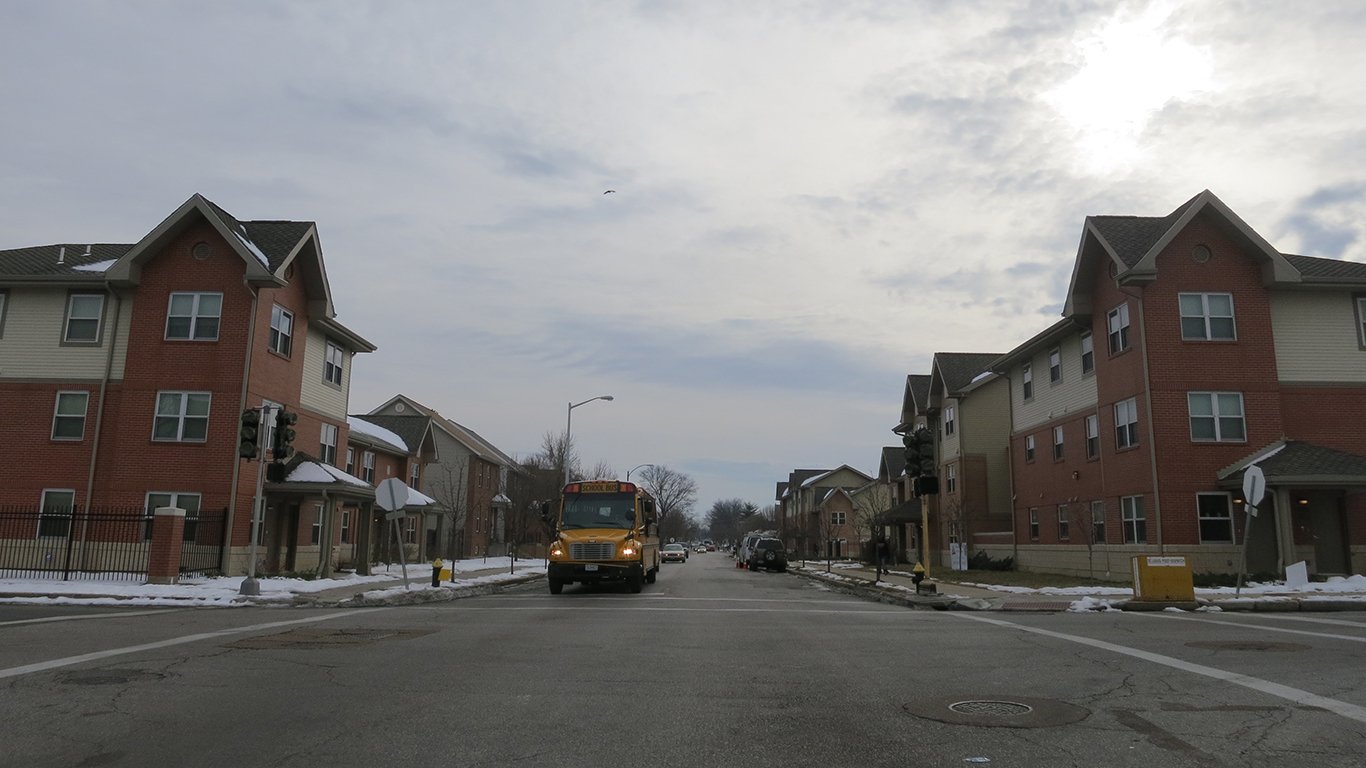
17. ZIP 63115 (St. Louis, Missouri)
> Vacant homes: 1,276 (17.3%)
> 5-yr. Population change: -10.7%
> Population: 18,799
> Median home value: $55,000
The 63115 ZIP code in St. Louis is located just north of the Central West End neighborhood along O’Fallon Park. It is one of several parts of the Missouri city to have near nation-leading home vacancy rates. Some 1,276 area homes, or 17.3% of all area homes, are vacant. The problem has gotten considerably worse recently, as last year, there were only 670 vacant properties in the area.
High vacancy rates can be tied to higher crime rates, and St. Louis is a relatively dangerous city. There were 455 violent crimes in greater St. Louis for every 100,000 people, well above the national violent crime rate of 369 per 100,000.
[in-text-ad-2]
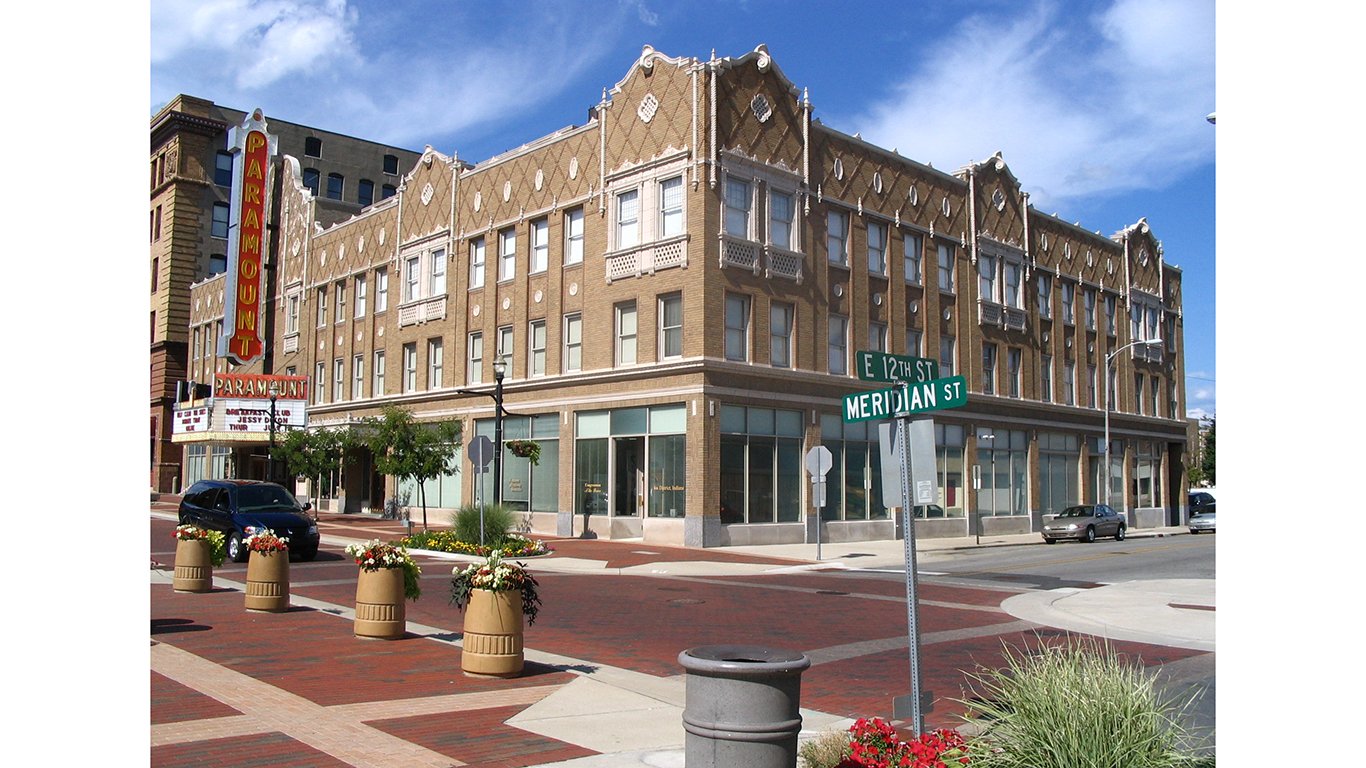
16. ZIP 46016 (Anderson, Indiana)
> Vacant homes: 1,248 (17.6%)
> 5-yr. Population change: -3.1%
> Population: 18,300
> Median home value: $41,500
There are 1,248 vacant properties in the 46016 ZIP code — located in Anderson, Indiana — up from 1,056 vacant properties a year ago. The urban decay evidenced by the large share of vacant properties in the Anderson area is due in part to poor regional economic conditions. Some 38.2% of area residents live below the poverty line, more than double the 14.6% national poverty rate.
Anderson is located within the Indianapolis metro area, which ranks among the most dangerous in the country. There were 642 violent crimes for every 100,000 people in greater Indianapolis in 2018, far more than the 369 per 100,000 national violent crime rate.
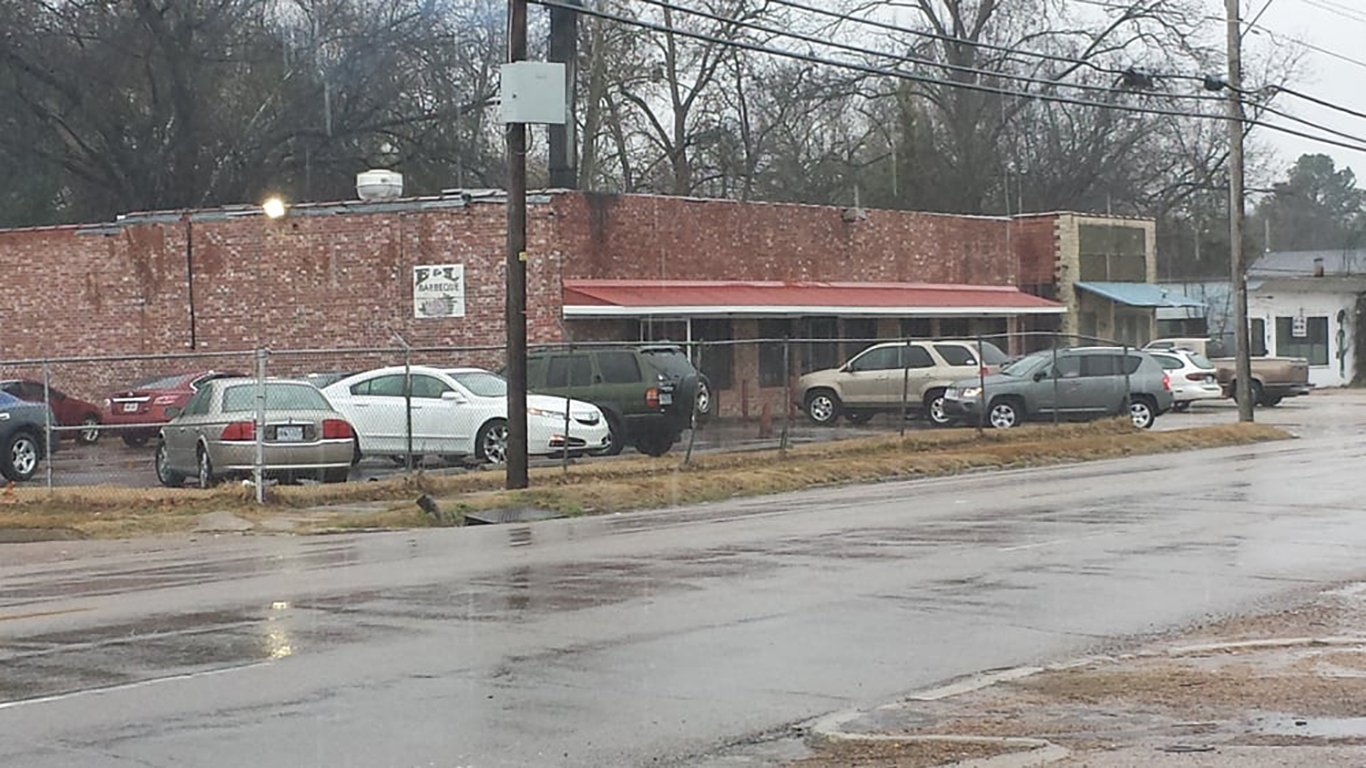
15. ZIP 39203 (Jackson, Mississippi)
> Vacant homes: 343 (17.7%)
> 5-yr. Population change: -6.2%
> Population: 6,250
> Median home value: $48,600
Few parts of the United States are as poor as the 39203 ZIP code around downtown Jackson, Mississippi, west of the Farish Street Historic District. Nearly half of all area residents live below the poverty line, and most households live on less than $20,000 a year.
Many of the poorest areas in the United States have high vacancy rates, and this part of the Mississippi state capital is no exception. Nearly 18% of all homes in the area are vacant, compared to just 1.6% of homes nationwide.
[in-text-ad]
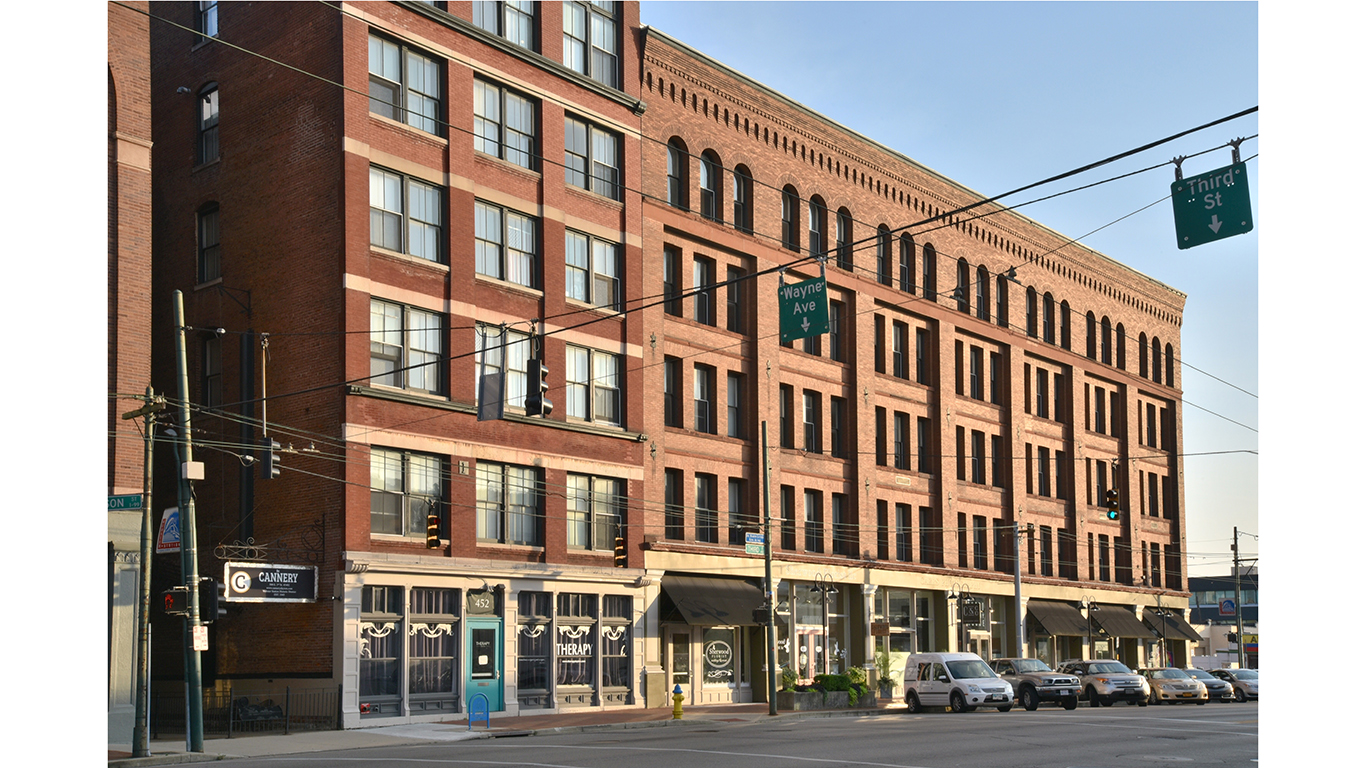
14. ZIP 45402 (Dayton, Ohio)
> Vacant homes: 725 (18.3%)
> 5-yr. Population change: -8.9%
> Population: 9,568
> Median home value: $56,200
Dayton, Ohio’s 45402 ZIP is centrally located in the city and is bisected by the Great Miami River. There are currently 725 vacant properties in the area, up from 574 a year ago. The growing vacancy problem is likely due in part to rapid population decline and the resultant reduced demand for housing. In the last five years, the number of people living in the Dayton ZIP code fell by 8.9%.
The area’s population decline is most likely attributable to poor economic conditions. The typical household in the area earns less than $25,000 a year, and over 42% of the population live in poverty, making the area one of the poorest in the United States.
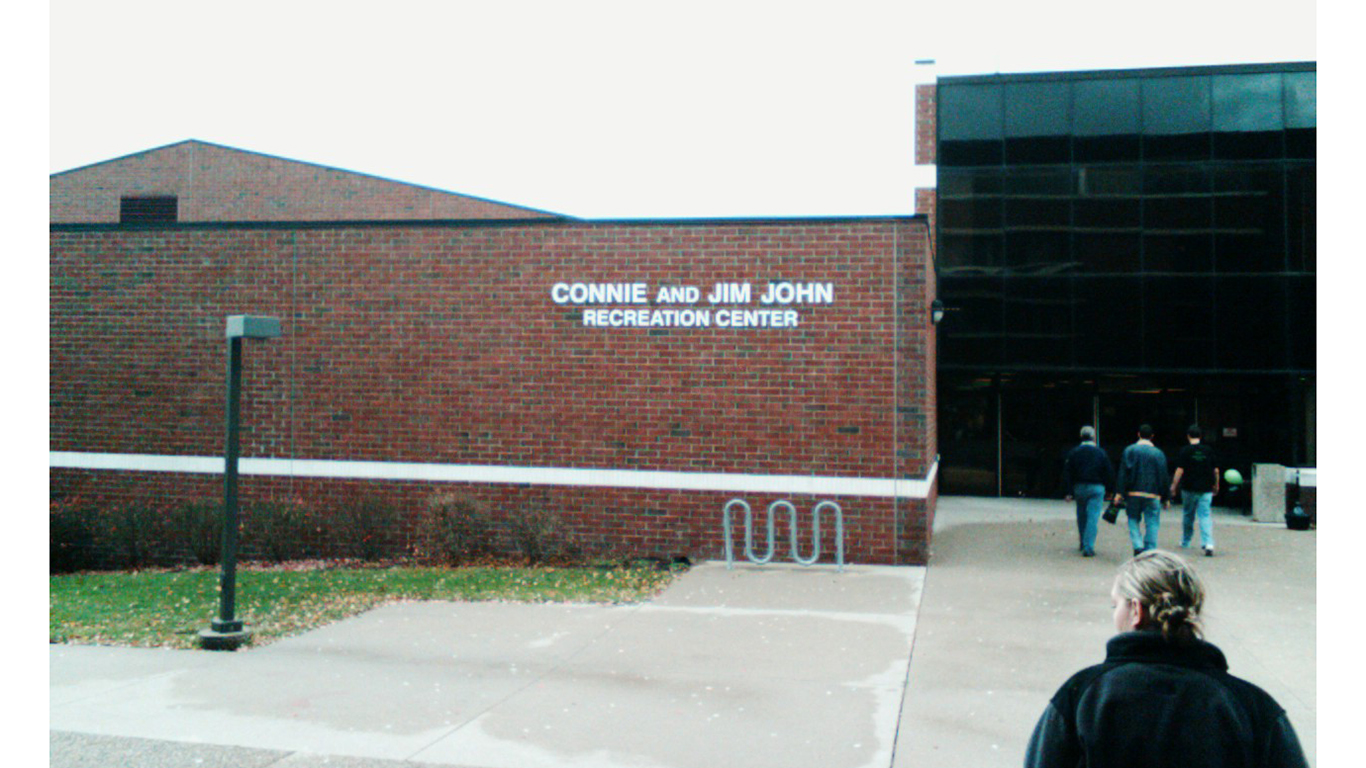
13. ZIP 48504 (Flint, Michigan)
> Vacant homes: 1,981 (18.5%)
> 5-yr. Population change: -7.5%
> Population: 28,316
> Median home value: $33,000
In a plan to reduce costs, Flint, Michigan, switched its water source from Lake Huron to the Flint River in April, 2014. Less than a year later, the EPA reported dangerous concentrations of lead in the Flint water supply. The contaminated water resulted in a public health crisis and criminal investigations against city officials.
The water scandal has also likely exacerbated the Rust Belt city’s vacant property crisis. In the last five years, the number of people living in Flint’s 48504 ZIP code declined by 7.5%, and area property values fell by a staggering 30.5%. Currently, nearly 2,000 homes in the area in the northwestern section of the city and beyond are vacant.
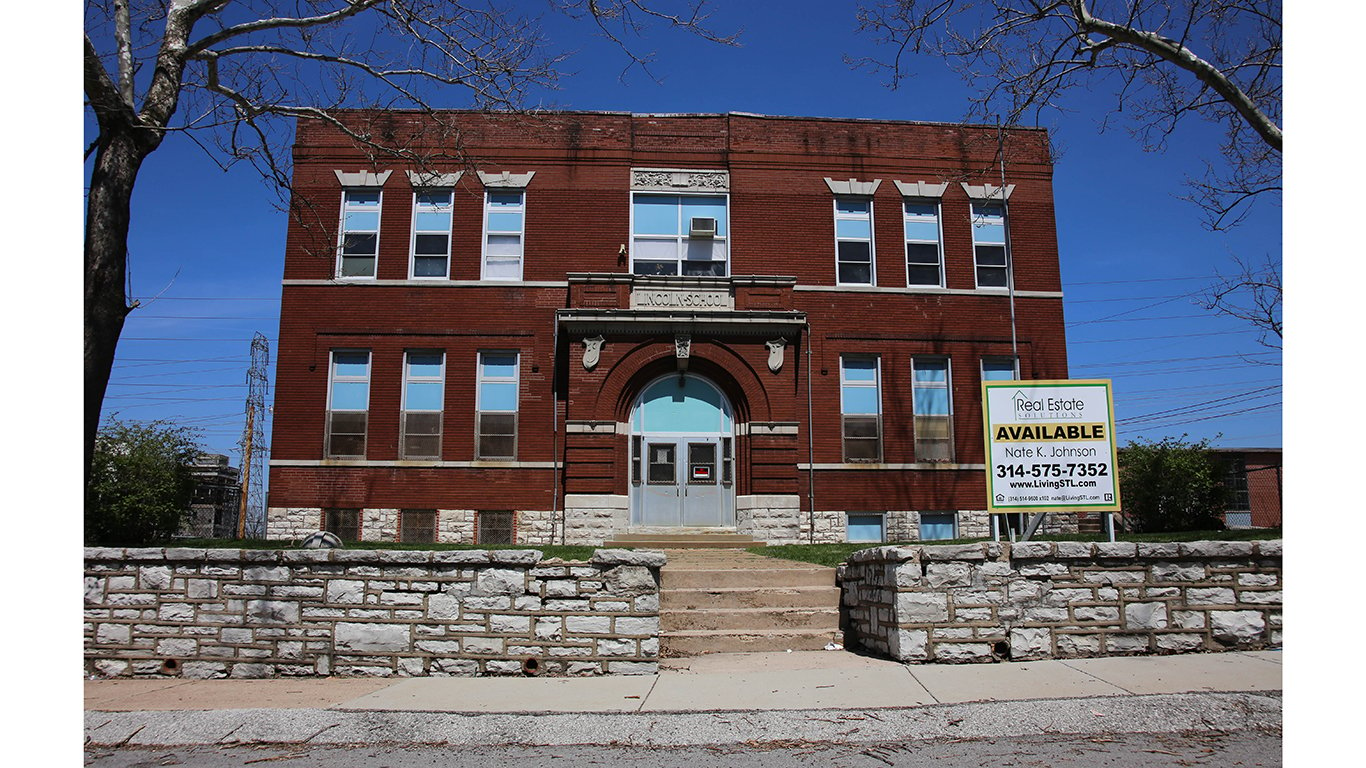
12. ZIP 63133 (St. Louis, Missouri)
> Vacant homes: 495 (18.5%)
> 5-yr. Population change: -11.1%
> Population: 7,299
> Median home value: $54,900
The 63133 ZIP code is located in St. Louis, Missouri, just north of Washington University and is bisected by route 180. Nearly 500 homes — or 18.5% of all homes — in the area are vacant, a 2.3% increase from last year.
As is the case in the majority of ZIP codes on this list, this part of St. Louis is reporting rapid population decline. In the last five years, the number of people living in the area fell by 11.1%. The resulting reduced demand for housing has likely dragged down real estate values. The typical area home is worth just $54,900, down 11.6% from the median home value in the area of $62,100 five years ago.
[in-text-ad-2]
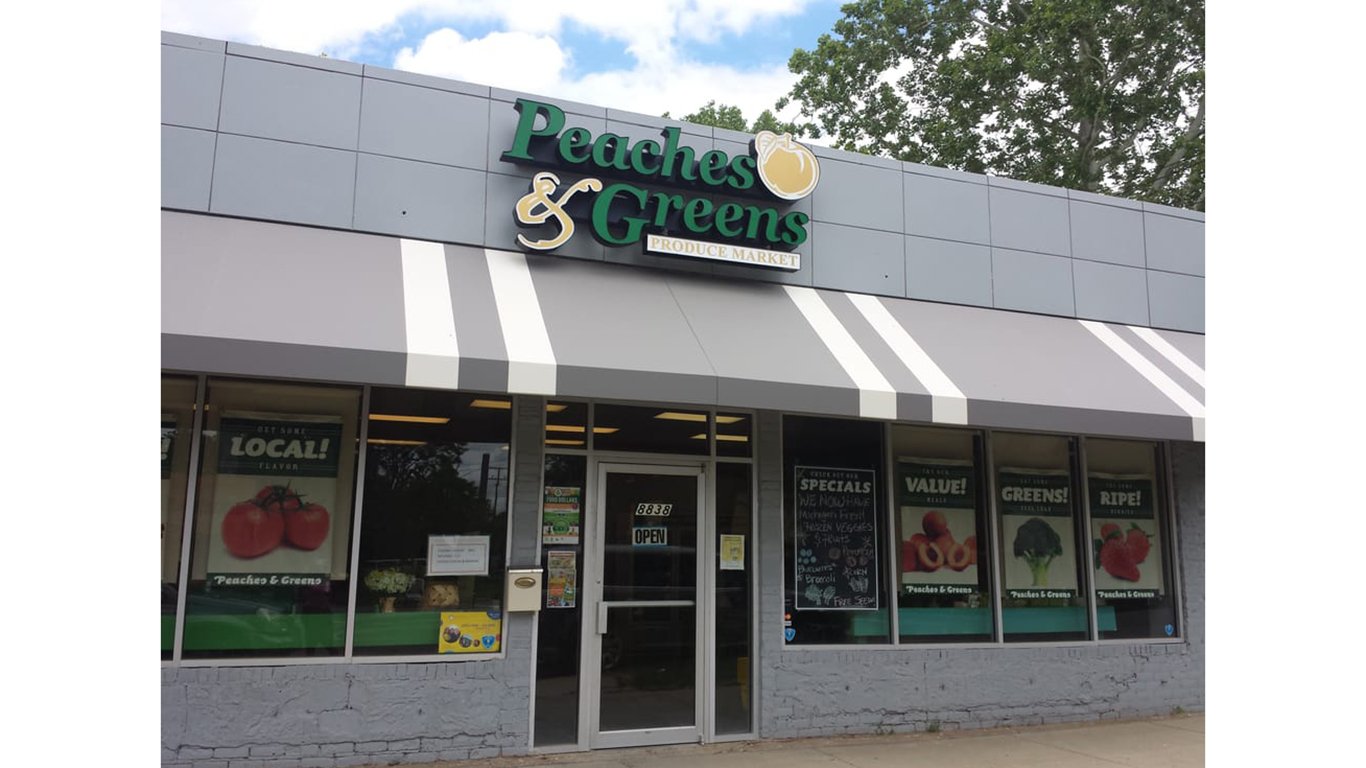
11. ZIP 48206 (Detroit, Michigan)
> Vacant homes: 1,056 (18.6%)
> 5-yr. Population change: -20.2%
> Population: 16,905
> Median home value: $48,100
Detroit’s 48206 ZIP code is contained almost entirely by I-94 and I-96 on the south and west and routes 10 and 8 on the east and north. Few cities have been hit as hard by the decline of American manufacturing as Detroit, and the 48206 ZIP code is evidence of the decline. There are over 1,000 vacant homes in the area, or 18.6% of all area homes.
The high home vacancy rate has likely been exacerbated by population decline. In the last five years, the number of people living in the area fell by a staggering 20.2%. The rapid population decline is likely due in part to a lack of economic opportunity. Nearly 38% of area residents live below the poverty line, and the unemployment rate across the broader Detroit metro area stands at 4.5% as of August, well above the comparable national unemployment rate of 3.8%.
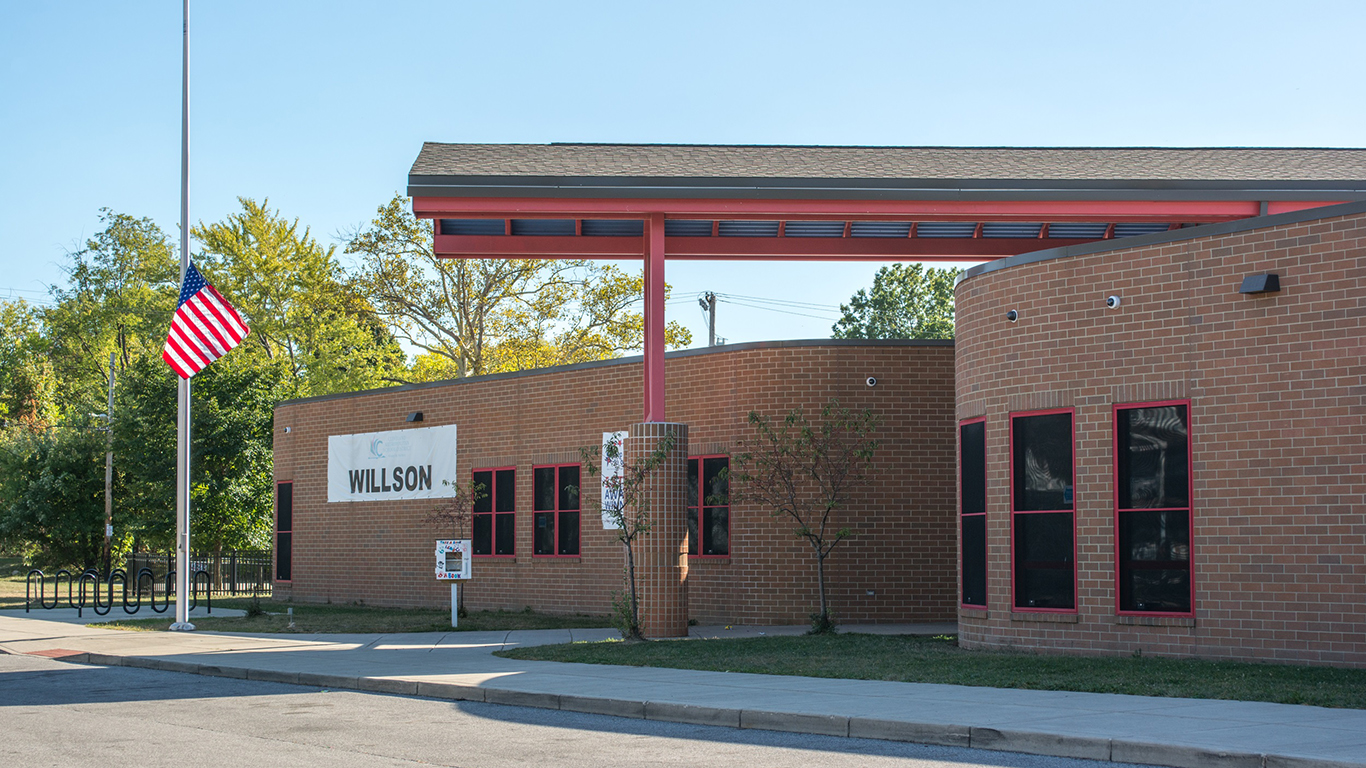
10. ZIP 44108 (Cleveland, Ohio)
> Vacant homes: 1,552 (18.6%)
> 5-yr. Population change: -13.0%
> Population: 22,048
> Median home value: $56,400
The 44108 ZIP code is located in northeastern Cleveland along the shore of Lake Erie. In the last five years, the number of people living in the area fell by a staggering 13.0%. The rapid population decline has led to reduced demand for housing, which has likely dragged down home values. The typical area home is worth just $56,400, down 15.3% from half a decade ago.
Like most ZIP codes on this list, 44108 is located in a city that has long suffered economically from the decline of American manufacturing. Since the industry began to decline and factories began to close in the mid-20th century, the city’s population was more than halved, from over 900,000 as of 1950 to less than 400,000 today.
[in-text-ad]
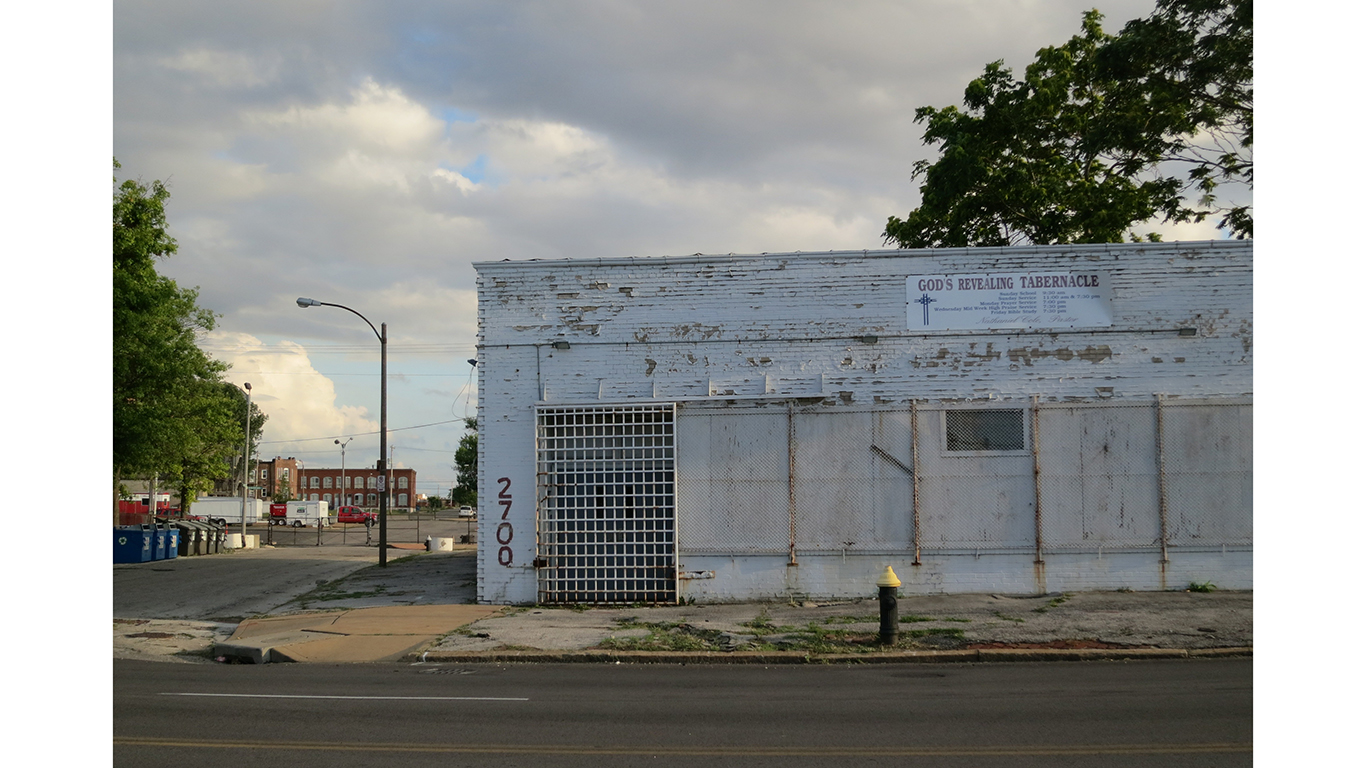
9. ZIP 63113 (St. Louis, Missouri)
> Vacant homes: 863 (18.9%)
> 5-yr. Population change: -8.6%
> Population: 11,184
> Median home value: $65,800
In the last five years, the number of people living in the 63113 ZIP code — located just north of the Central West End neighborhood in St. Louis — declined by 8.6%. The area’s high vacancy rate of 18.9% is likely partially the result of long-term population decline.
As is often the case, many of the vacant properties in this part of St. Louis are investment properties — meaning they are likely either on the rental market or waiting to be sold at a profit by the owner. If recent trends are any indication, it may be a while before a real estate investment in the area pays off. The typical area home is worth just $65,800, down 1.2% from five years ago. Over the same period, the typical American home has appreciated in value by 9.5%.
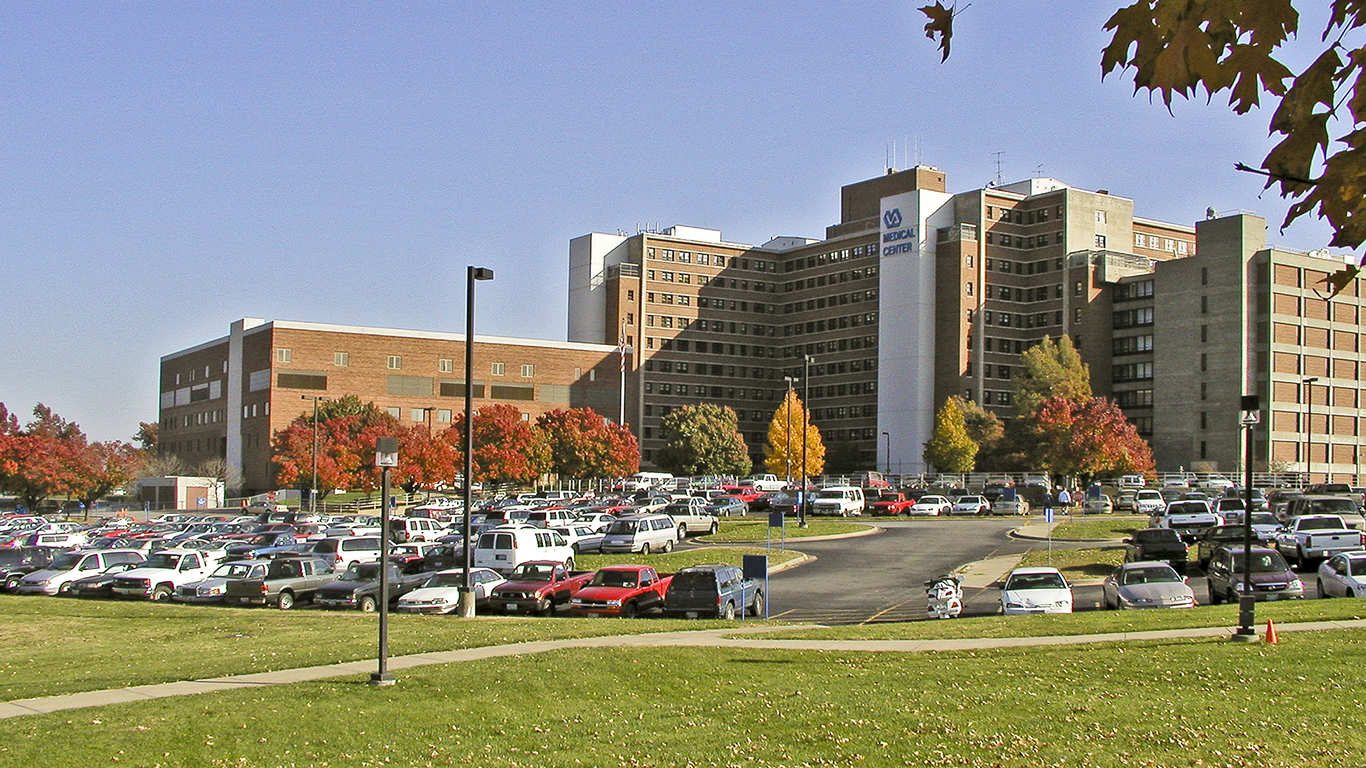
8. ZIP 64128 (Kansas City, Missouri)
> Vacant homes: 934 (18.9%)
> 5-yr. Population change: -2.3%
> Population: 12,056
> Median home value: $38,900
The 64128 ZIP code in Kansas City covers the Knoches Park, Oak Park Northwest, Palestine East, and Sante Fe neighborhoods, as well as Ingleside, a particularly high crime neighborhood. In Kansas City, violent crime — especially homicide — tends to be concentrated in areas with high vacant property rates.
High crime and a high vacancy rate are likely depressing home values. The typical home in the 64128 ZIP code is worth just $38,900, 22% less than it was worth five years ago.
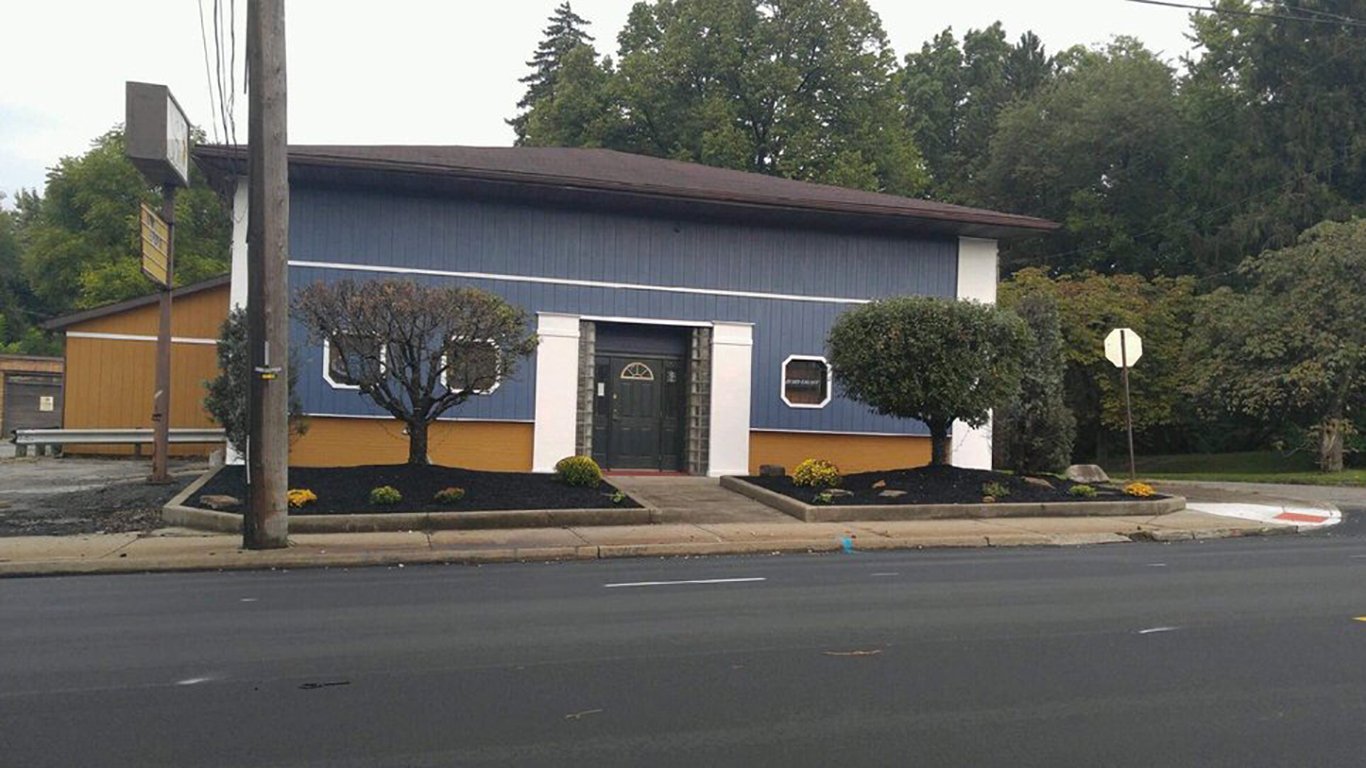
7. ZIP 44507 (Youngstown, Ohio)
> Vacant homes: 437 (21.5%)
> 5-yr. Population change: -8.0%
> Population: 5,093
> Median home value: $22,100
There are 437 vacant homes — more than one in every five — in the 44507 zip code, which is in the south-central part of Youngstown, Ohio. Population decline in recent years has likely exacerbated the problem. In the last five years, the number of people living in the area fell by 8.0%. As in most places reporting a population decline and a high vacancy rate, property values in the 44507 ZIP code are near rock bottom. The typical area home is worth just $22,100, about $170,000 below the value of the typical American home.
Economic problems and population decline across Youngstown began in the 1970s and ’80s, with the decline of the city’s once dominant steel industry. The lack of economic opportunity in the area remains a root cause of the high vacancy rate. Across the broader Youngstown metro area, August 2019 unemployment stands at 6.0%, well above the comparable 3.8% national unemployment rate.
[in-text-ad-2]
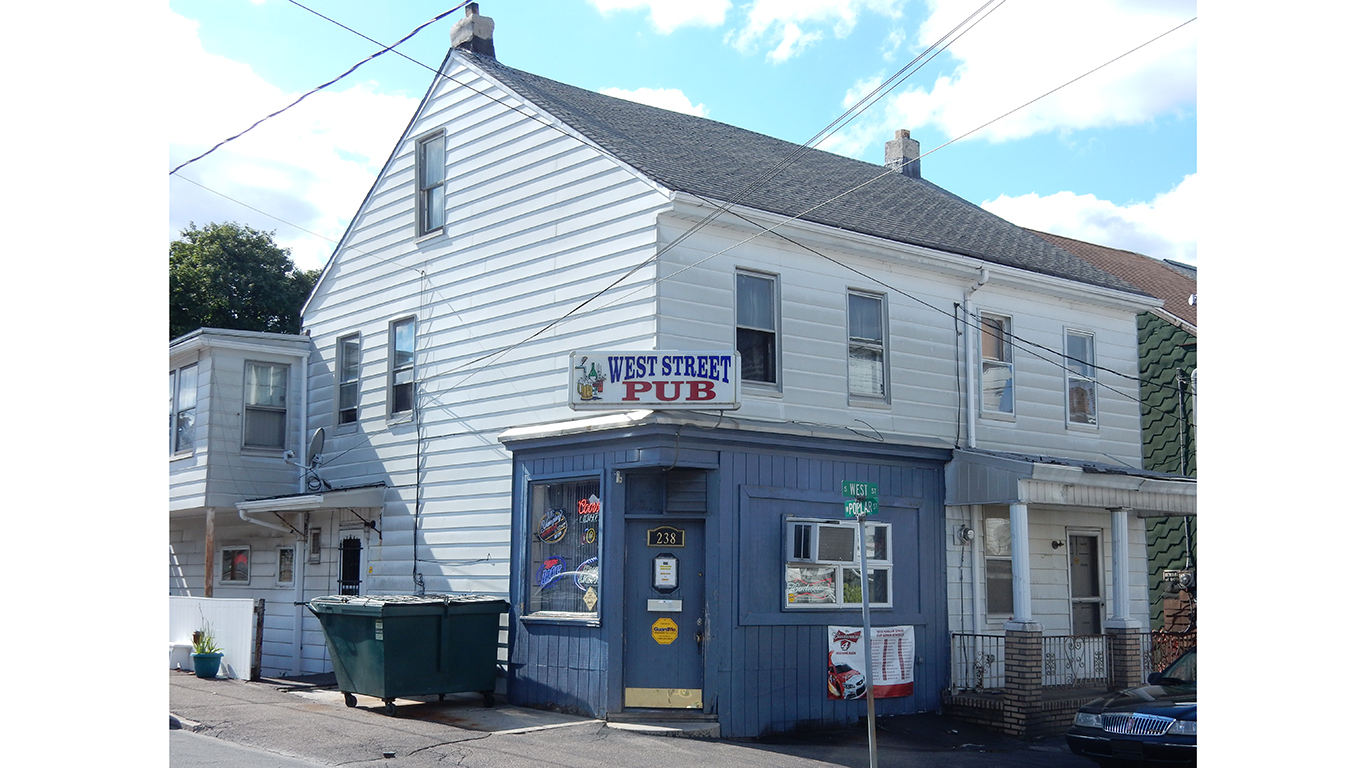
6. ZIP 17976 (Shenandoah, Pennsylvania)
> Vacant homes: 759 (23.9%)
> 5-yr. Population change: -3.1%
> Population: 6,715
> Median home value: $34,700
Pennsylvania’s 17976 ZIP code comprises the borough of Shenandoah, about 140 miles west of New York City. An economically depressed area, a staggering 38.6% of residents live below the poverty line, and over half of all area homes are worth less than $35,000. Low property values and high vacancy rates tend to go hand in hand, and in Shenandoah, there are 759 vacant dwellings — nearly 25% of homes.
A coal mining town in the early 1900s, Shenandoah has long been in decline. The industry all but shut down in the area over half a century ago.
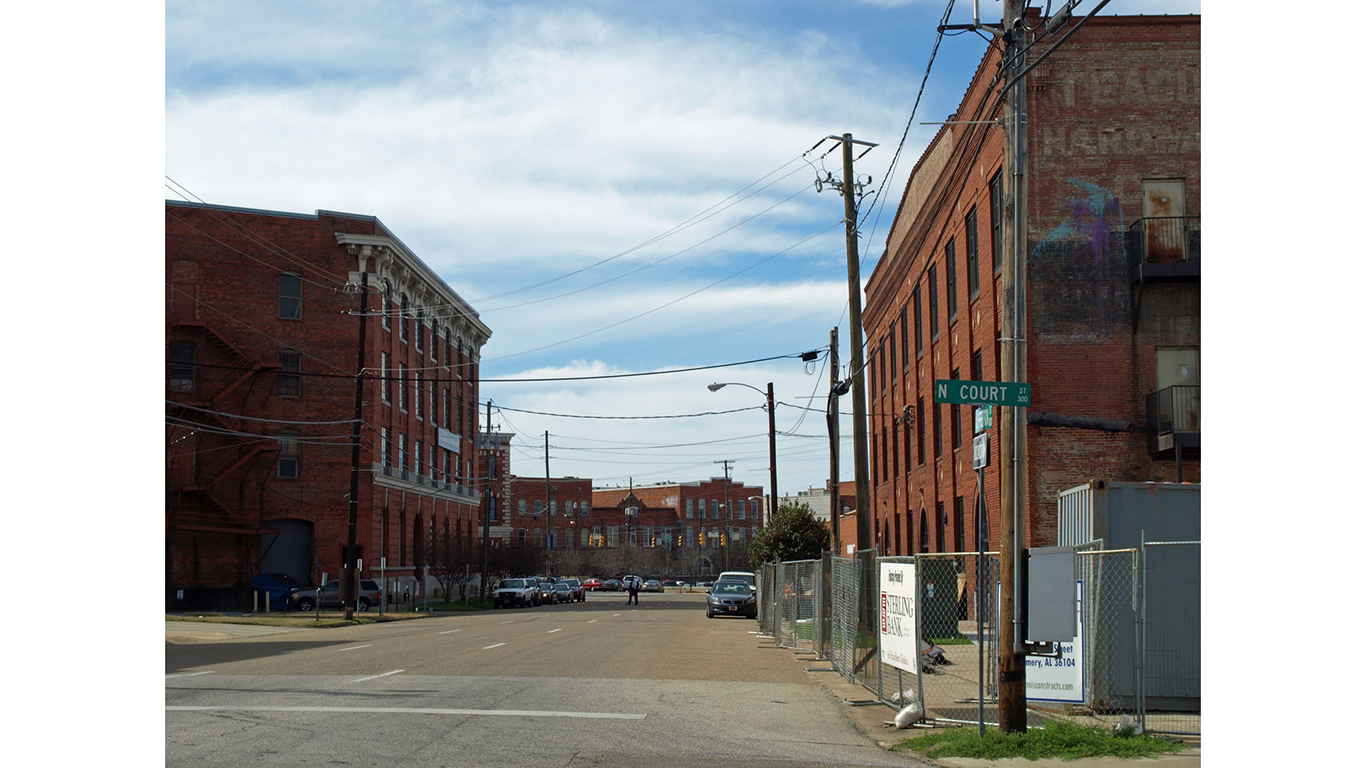
5. ZIP 36104 (Montgomery, Alabama)
> Vacant homes: 591 (24.0%)
> 5-yr. Population change: -10.0%
> Population: 8,040
> Median home value: $74,200
The 36104 ZIP code, located in Northern Montgomery, Alabama, along Gun Island Chute, is one of several parts of the Alabama state capital with a near nation-leading home vacancy rate. There are 591 vacant properties in the area, up from 523 a year ago. Of the vacant homes, 491 are classified as investment properties — meaning they are likely either on the rental market or waiting to be sold at a profit by the owner, but that might be a while.
Home values have not appreciated in the area in recent years. The typical home in the ZIP code is worth just $74,200, 6.9% less than it was worth five years ago.
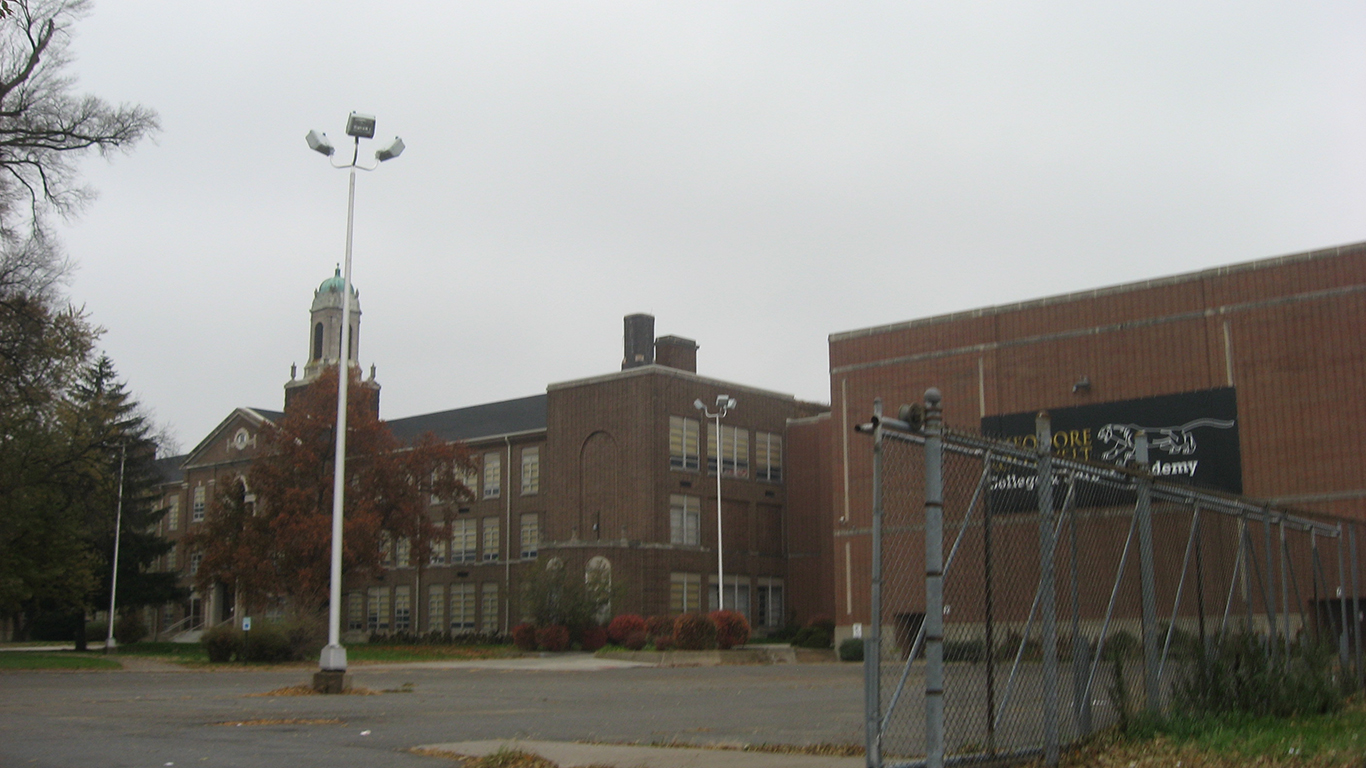
4. ZIP 46407 (Gary, Indiana)
> Vacant homes: 1,306 (28.2%)
> 5-yr. Population change: -8.9%
> Population: 11,657
> Median home value: $51,600
Bisected by Route 53 and with I-94 along southern border, 46407 is one of five ZIP codes in Gary, Indiana, with a vacancy rate high enough to rank on this list. Some 28.2% of residential properties in the area are vacant, compared to just 1.6% of homes nationwide.
People have been leaving the area in droves in recent years. Between 2013 and 2017, the number of people living in the ZIP code fell by 8.9%, from 12,798 to 11,657. Over the same period, with waning demand for housing, the median home value in the area fell by 9.9%, from $57,300 to $51,600.
[in-text-ad]
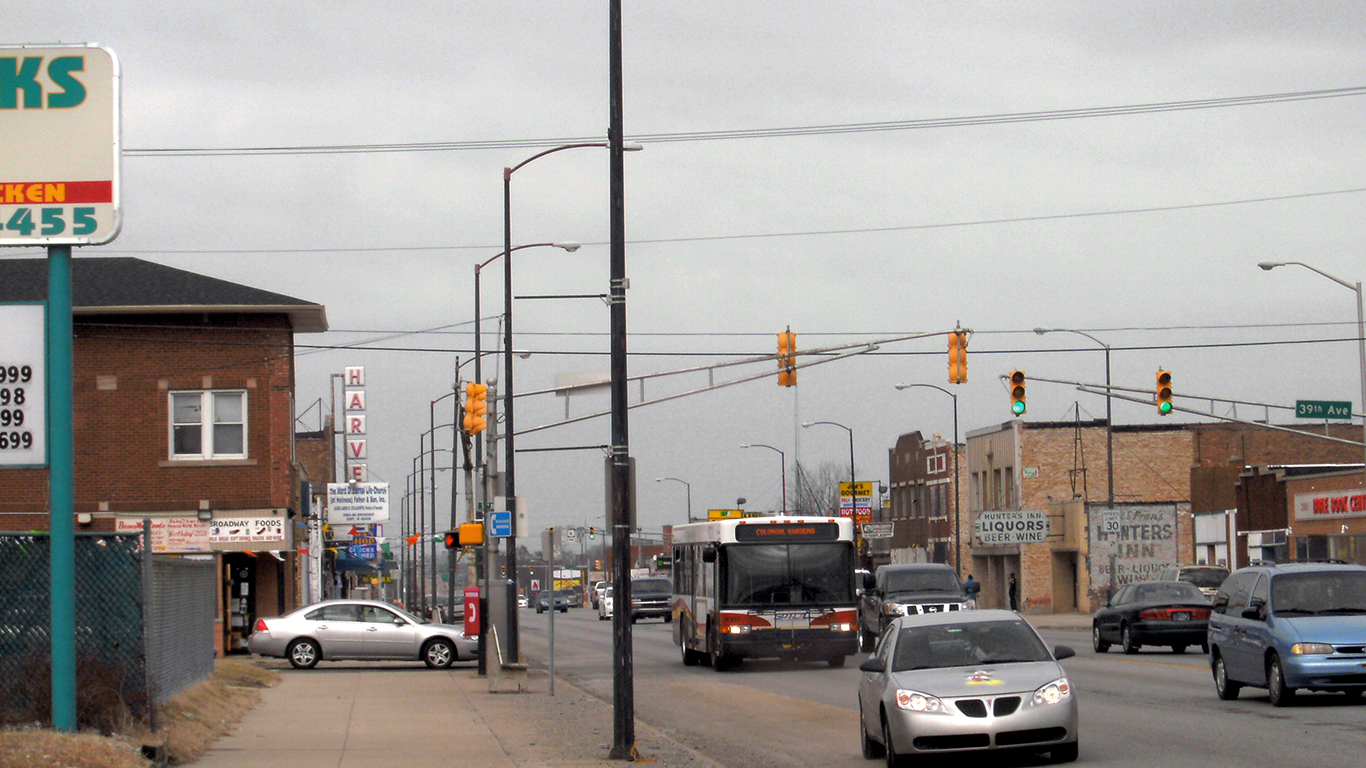
3. ZIP 46409 (Gary, Indiana)
> Vacant homes: 1,190 (30.8%)
> 5-yr. Population change: -16.7%
> Population: 7,625
> Median home value: $59,500
The 46409 ZIP code is bordered by Route 53, I-94, and I-65 in southern Gary, Indiana. Some 1,190 homes in the area vacant, a 1.9% increase from a year ago, when 1,081 area homes were vacant. Like many neighborhoods on this list, the 46409 ZIP code is a poor place. More than one in every three residents live below the poverty line, more than double the 14.6% national poverty rate.
Gary is one of several once-great American manufacturing hubs that have suffered economic and population decline. Over the last five years alone, the number of people living in the 46409 ZIP code fell by a staggering 16.7%.
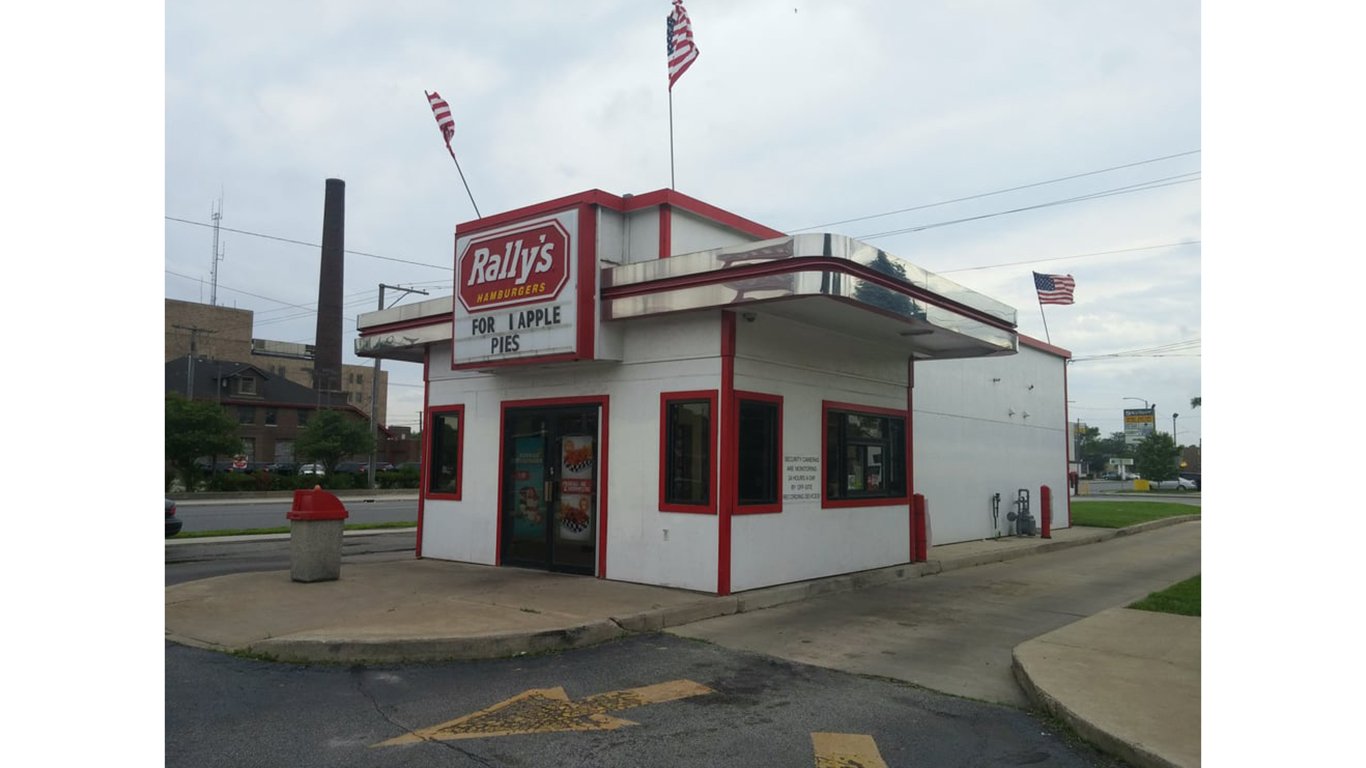
2. ZIP 46402 (Gary, Indiana)
> Vacant homes: 648 (31.3%)
> 5-yr. Population change: -7.2%
> Population: 6,128
> Median home value: $59,000
Of the several neighborhoods in Gary, Indiana, to rank on this list, none has a larger share of vacant homes than the 46402 ZIP, which extends from Central Ave to the Lake Michigan shore. Nearly 650 properties in the area are vacant, and the availability of residential space has likely driven down home prices. The typical home in the ZIP code is worth just $59,000, a fraction of the median home value of $193,500 nationwide.
Low home values have created an opportunity for real estate investors in the area. Some 447 vacant homes in the area are classified as investment properties. Whether those investments will bear fruit any time soon remains to be seen.
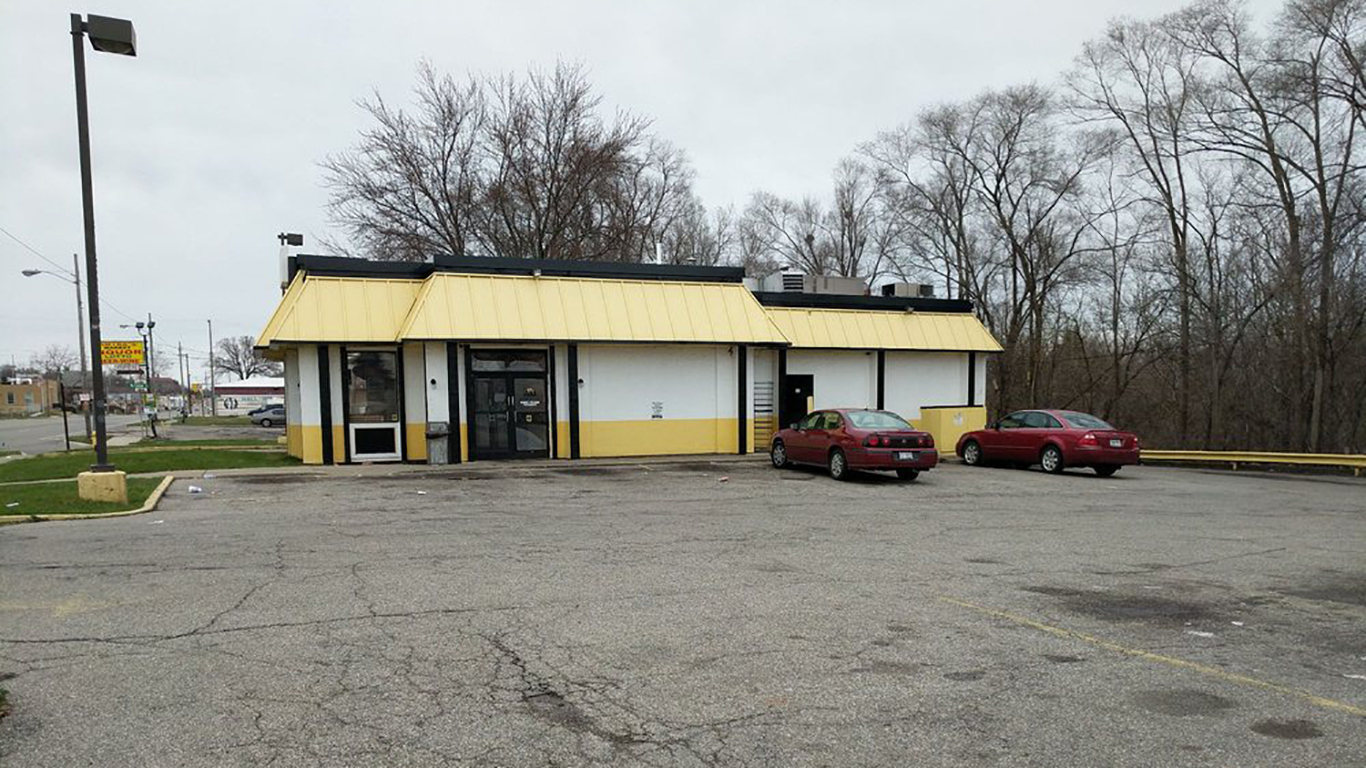
1. ZIP 48505 (Flint, Michigan)
> Vacant homes: 3,041 (31.3%)
> 5-yr. Population change: -9.7%
> Population: 21,086
> Median home value: $22,700
Few parts of the country have known the level of urban decay that Flint, Michigan, has in recent years. The city, which was already economically distressed following the declining presence of General Motors as a major employer in the city was hit with a public health crisis after it was discovered in 2015 that the city’s water supply was contaminated with dangerous levels of lead.
The crisis pushed many out of the city and provided little incentive for any would-be buyers to invest in area real estate. In the last five years, the number of people living in the 48505 ZIP code, located just north of downtown Flint, fell by nearly 10%. Currently, the typical household in Flint’s 48505 ZIP code is worth just $22,700, and 31.3% of area homes are vacant, the largest share of any ZIP code considered.
Methodology
To identify America’s 30 ghost towns, 24/7 Wall St. reviewed the share of single-family homes and condos that are unoccupied in 16,148 ZIP codes with at least 1,000 single family homes and condos. Occupancy status was determined by ATTOM Data Solutions using tax assessor data for the end of the third quarter in 2019.
To better identify areas with vacancy rates that remain high year round and are not likely to decrease significantly in the near future, we only considered ZIP codes with five-year population growth of less than 5%. We also excluded ZIP codes where a large share of properties are likely vacant due to seasonal variation. This includes beach towns and places and other vacation destinations.
Median household income, median home value, poverty rates, and population at the ZIP code level are all five-year estimates from the U.S. Census Bureau’s 2017 American Community Survey. Five-year changes in population and median home value are for between 2013 and 2017 are also from the ACS. Violent crime and homicide rates at the metro area level are from the FBI’s 2018 Uniform Crime Report.
Sponsored: Find a Qualified Financial Advisor
Finding a qualified financial advisor doesn’t have to be hard. SmartAsset’s free tool matches you with up to 3 fiduciary financial advisors in your area in 5 minutes. Each advisor has been vetted by SmartAsset and is held to a fiduciary standard to act in your best interests. If you’re ready to be matched with local advisors that can help you achieve your financial goals, get started now.
Thank you for reading! Have some feedback for us?
Contact the 24/7 Wall St. editorial team.
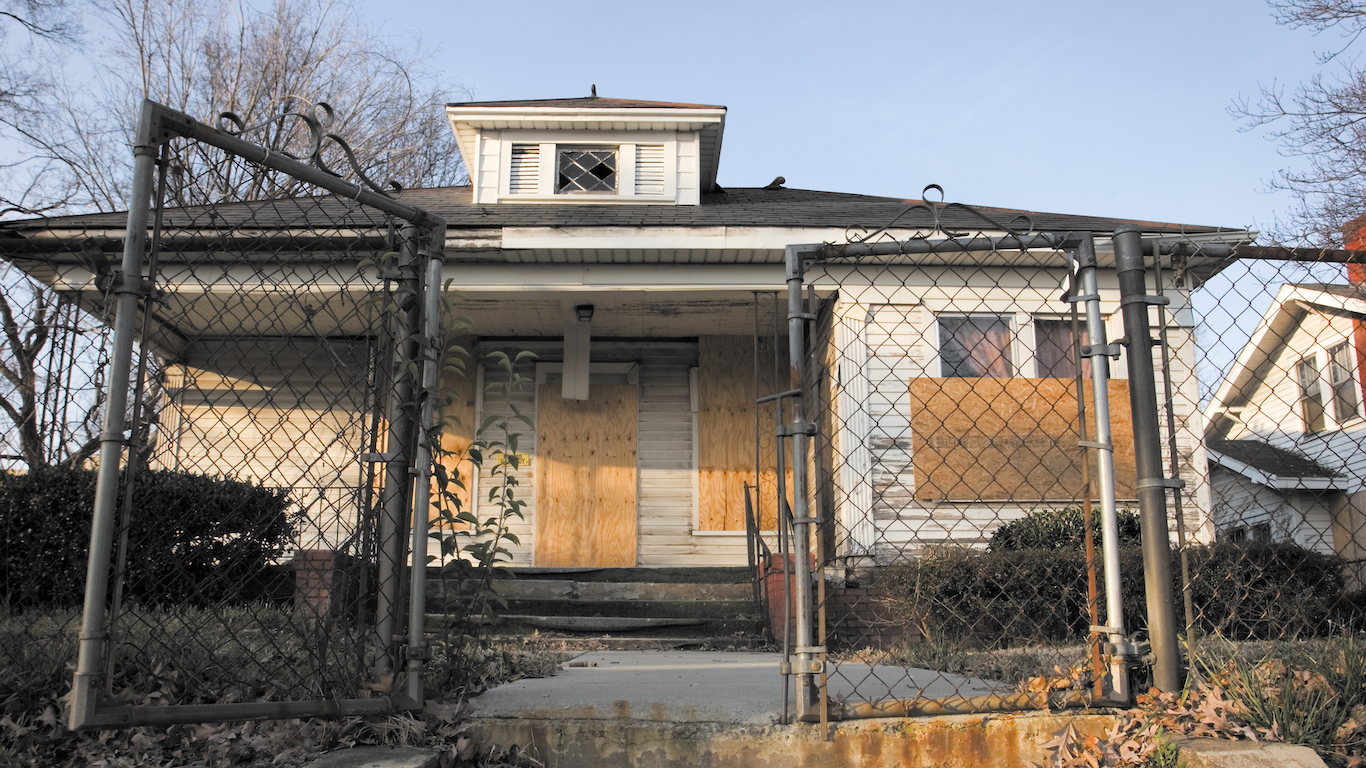 24/7 Wall St.
24/7 Wall St.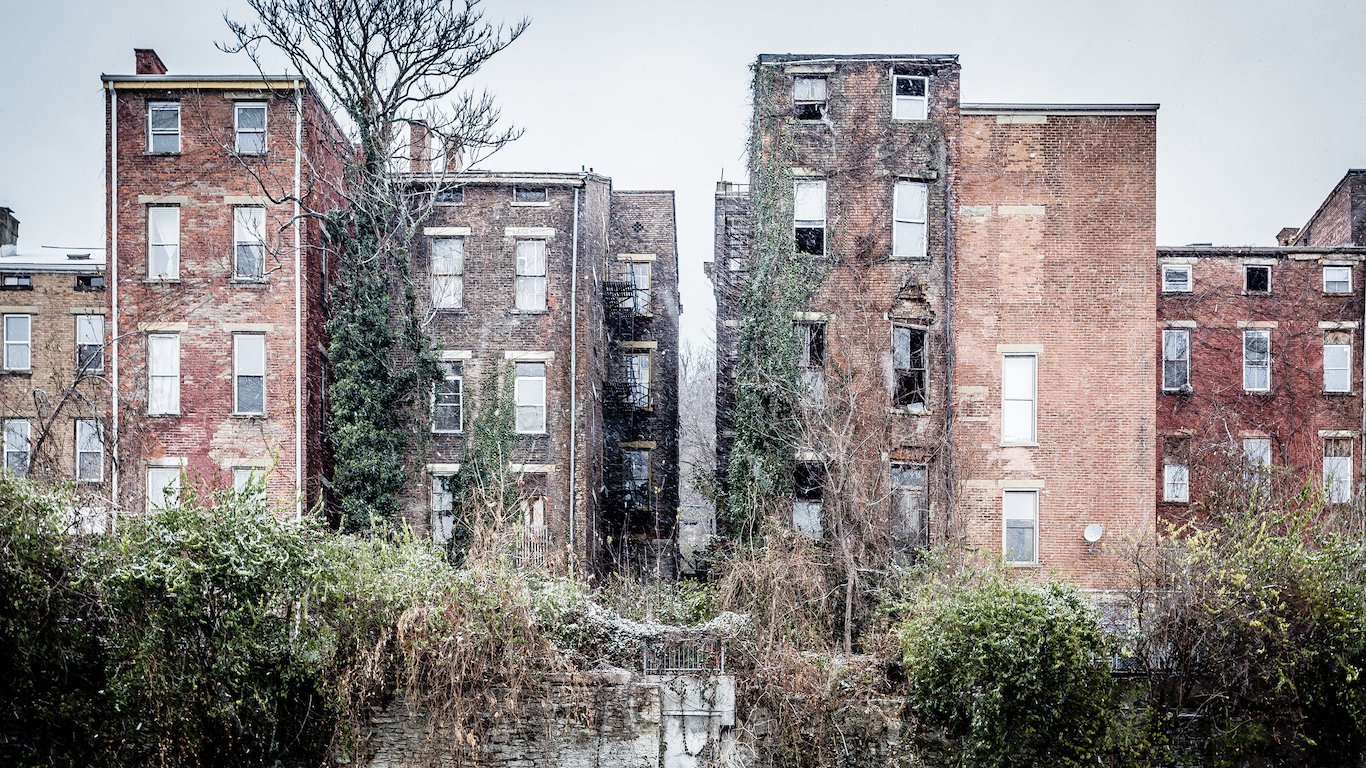 24/7 Wall St.
24/7 Wall St. 24/7 Wall St.
24/7 Wall St.